| North Texas Weather Data
Climate Forecasts, severe weather analysis data, weather trends, and current conditions are all found here!
Weather Center presents its finest Radar collection all compiled into one main page. Come check it out here at Dallas Weather Data! Navigate to WC’s other data-rich pages to find out more about the current weather!
Current Forecast
Current Weather Conditions
6 Day Weather Forecast
Pollen Counts
Fire Weather Danger
Precipitation Outlook / Forecast Maps
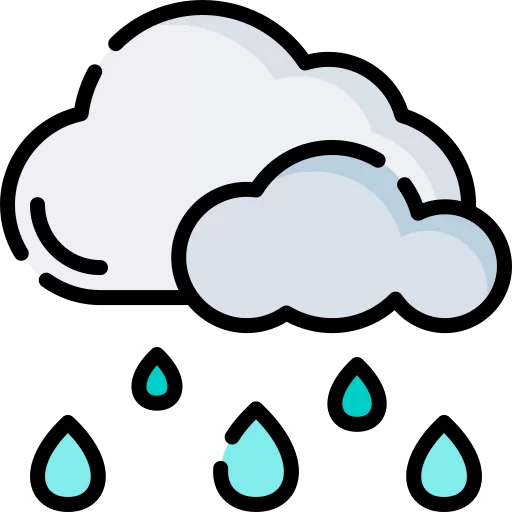
Day 1

Day 2

Day 3
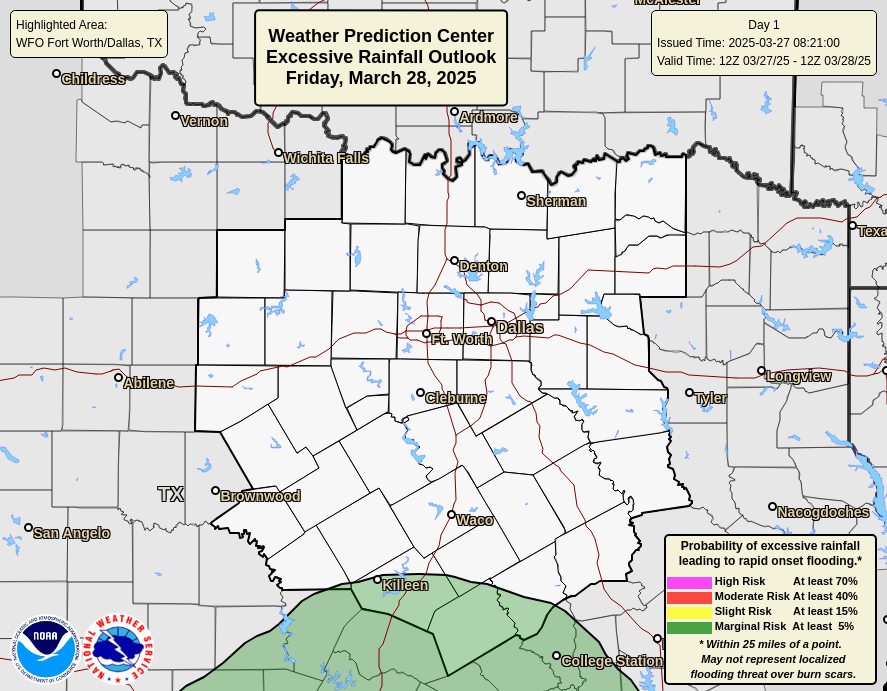
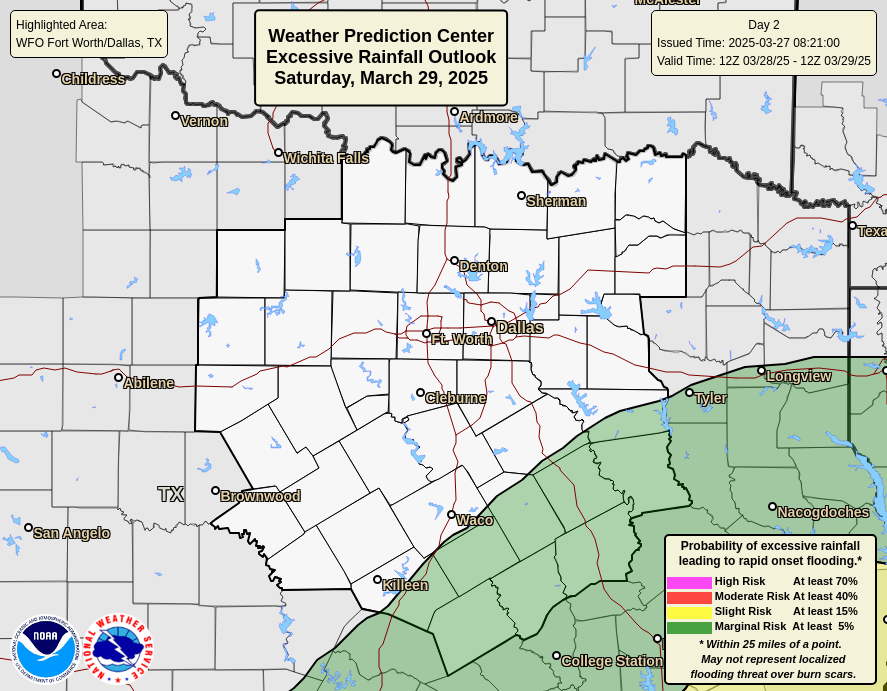
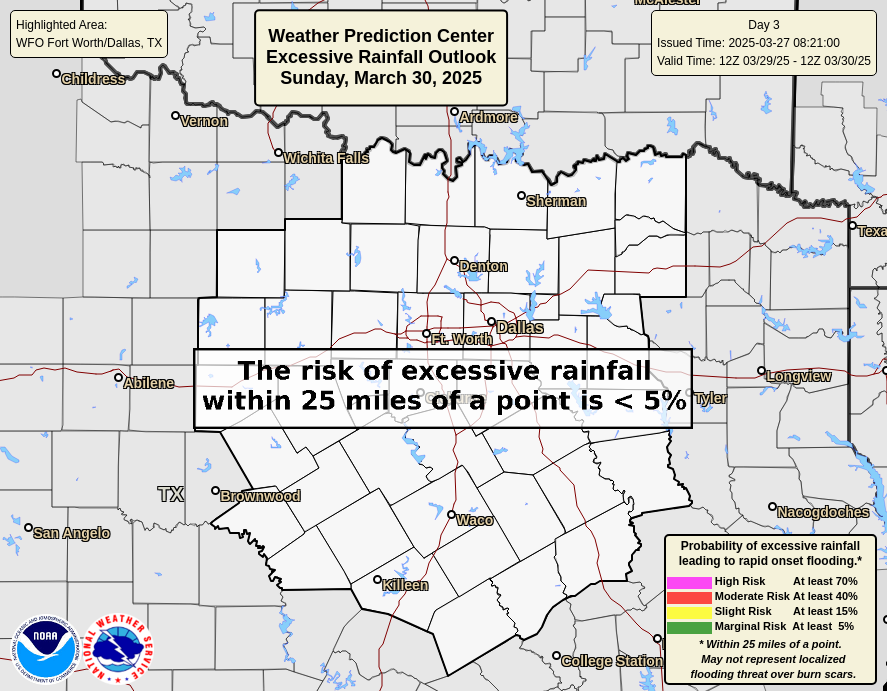
An Excessive Rainfall Outlook is a meteorological prediction that assesses the risk of heavy rainfall events that could lead to flooding and related hazards. It’s a crucial tool for disaster management, offering insight into areas where excessive rain is anticipated. This information aids emergency services, agriculture, and infrastructure planning. Excessive rainfall outlooks, typically covering short to medium-term time frames, help authorities prepare for potential flooding incidents and protect lives and property. These forecasts are especially significant during severe weather events like thunderstorms or tropical storms, as intense rainfall can overwhelm drainage systems and cause flash floods. They rely on advanced weather models and data to provide timely and precise information for public safety and disaster preparedness.
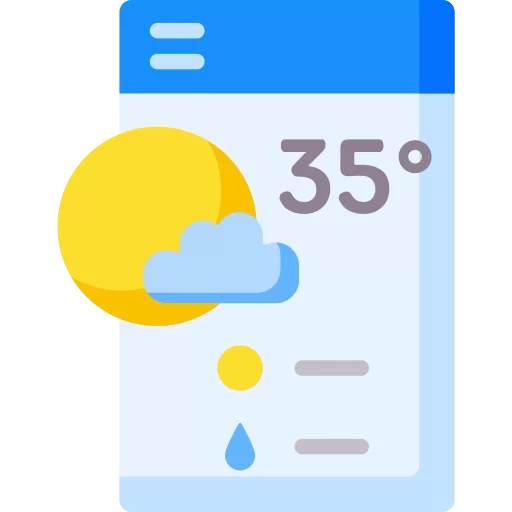
Day 1

Day 2

Day 3

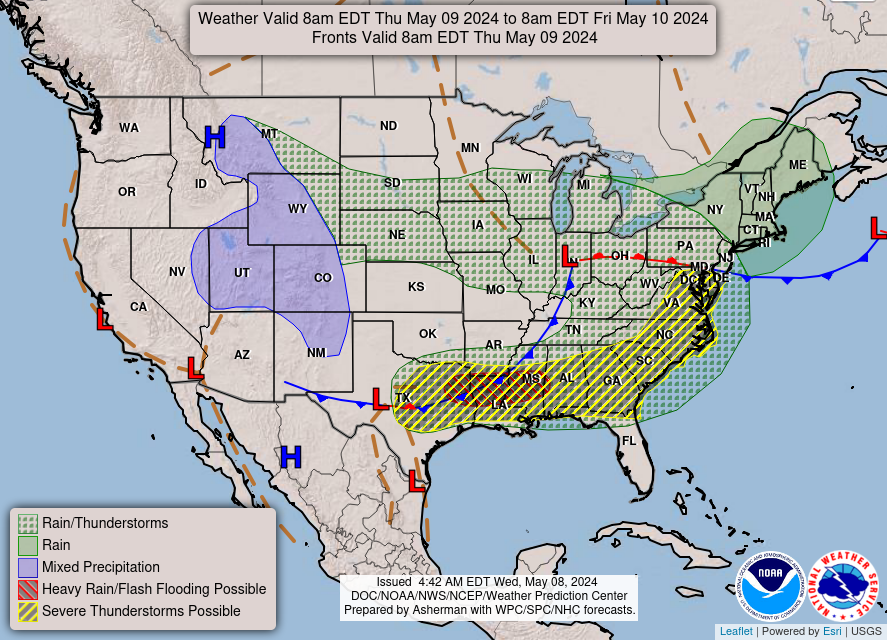
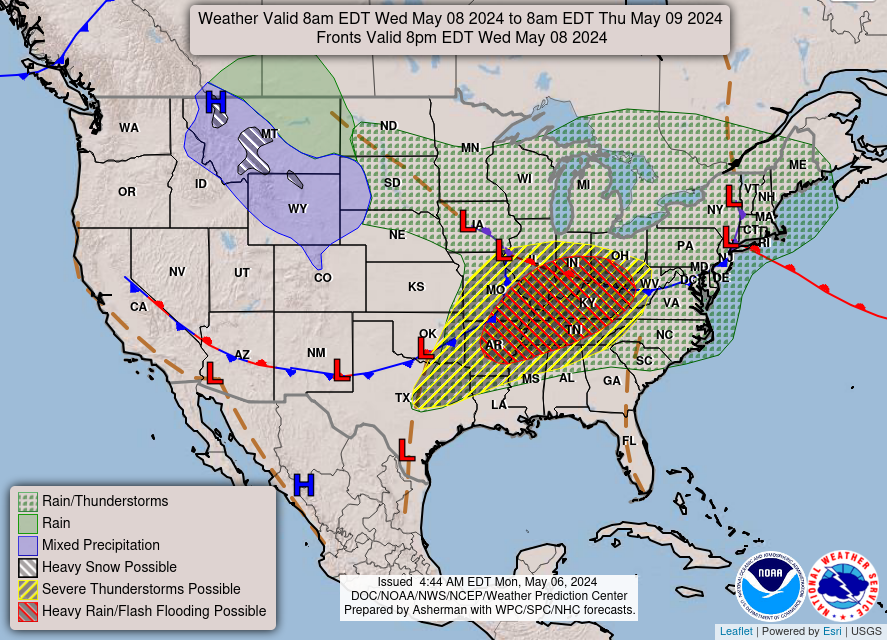
A National Forecast Chart is a comprehensive weather map that provides an overview of expected weather conditions across an entire country or region. It typically includes information on temperature, precipitation, wind direction and speed, and atmospheric pressure. These charts are widely used for weather forecasting, allowing meteorologists to convey a snapshot of the upcoming weather patterns to the public and various sectors like aviation, agriculture, and disaster management. National Forecast Charts are essential tools for understanding and planning for weather-related events, making them valuable for decision-making, especially when it comes to public safety, transportation, and outdoor activities. These charts are updated regularly to reflect changing weather conditions and are accessible to the general public through the Weather Prediction Center.
Short-Range Climate Outlook

6-10 Day Temperature

8-14 Day Temperature


A Short Range Temperature Outlook is a forecast that provides a relatively near-term prediction of temperature conditions over a brief time frame, typically spanning a few days to a week. These outlooks are highly valuable for daily planning and immediate decision-making in various sectors, including agriculture, energy, and outdoor activities.
Short-range temperature outlooks offer information about expected temperature trends, helping individuals and businesses make real-time decisions. For instance, farmers can determine when to protect crops from frost, and energy providers can anticipate energy demand for heating or cooling. Additionally, these outlooks are crucial for public health planning, allowing people to prepare for extreme temperatures that could affect their safety and well-being.
Short-range temperature forecasts are based on the latest meteorological data and models, which provide reasonably accurate predictions for the near future. They are an essential tool for making informed, short-term decisions, optimizing daily activities, and ensuring the safety and comfort of communities.

6-10 Day Precipitation

8-14 Day Precipitation


A Short Range Precipitation Outlook is a forecast that offers predictions for expected precipitation, such as rain or snow, over a relatively brief time frame, typically ranging from a few hours to a few days. These forecasts are invaluable for immediate decision-making and planning in various sectors, including agriculture, water resource management, and emergency services.
Short-range precipitation outlooks provide information on when, where, and how much precipitation is likely to occur, enabling people and organizations to prepare and respond accordingly. For example, farmers use these forecasts to determine irrigation needs and whether to protect crops from excessive rainfall. Emergency services can prepare for potential flooding events, while urban planners may activate flood control measures. Additionally, short-range precipitation outlooks are critical for public safety, as they help individuals and communities plan for weather-related events and mitigate their impact.
These forecasts are based on the most recent meteorological data and models, making them reliable tools for short-term planning and response to changing weather conditions.
Long-Range Climate Outlook

3 Months

6 Months

9 Months

12 Months

15 Months
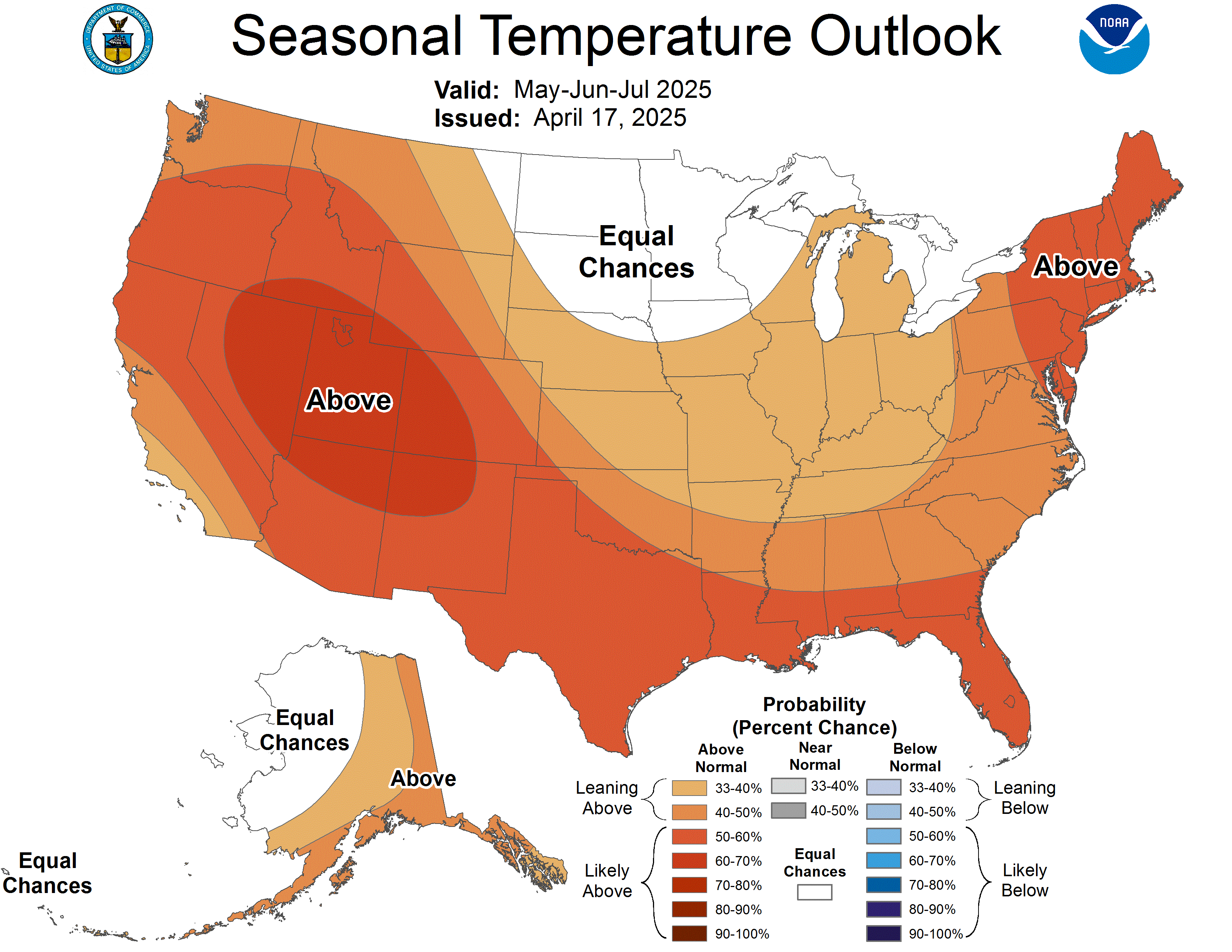
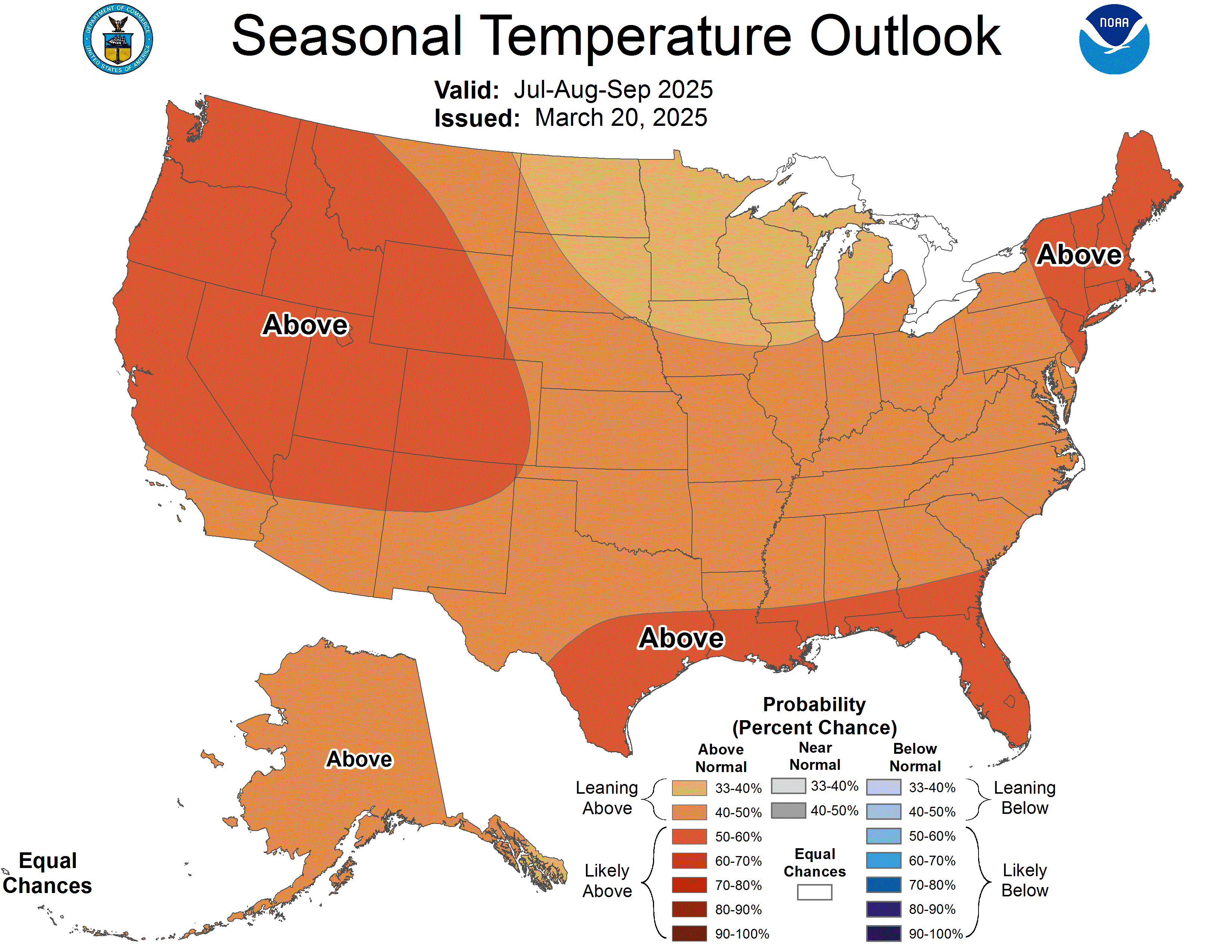
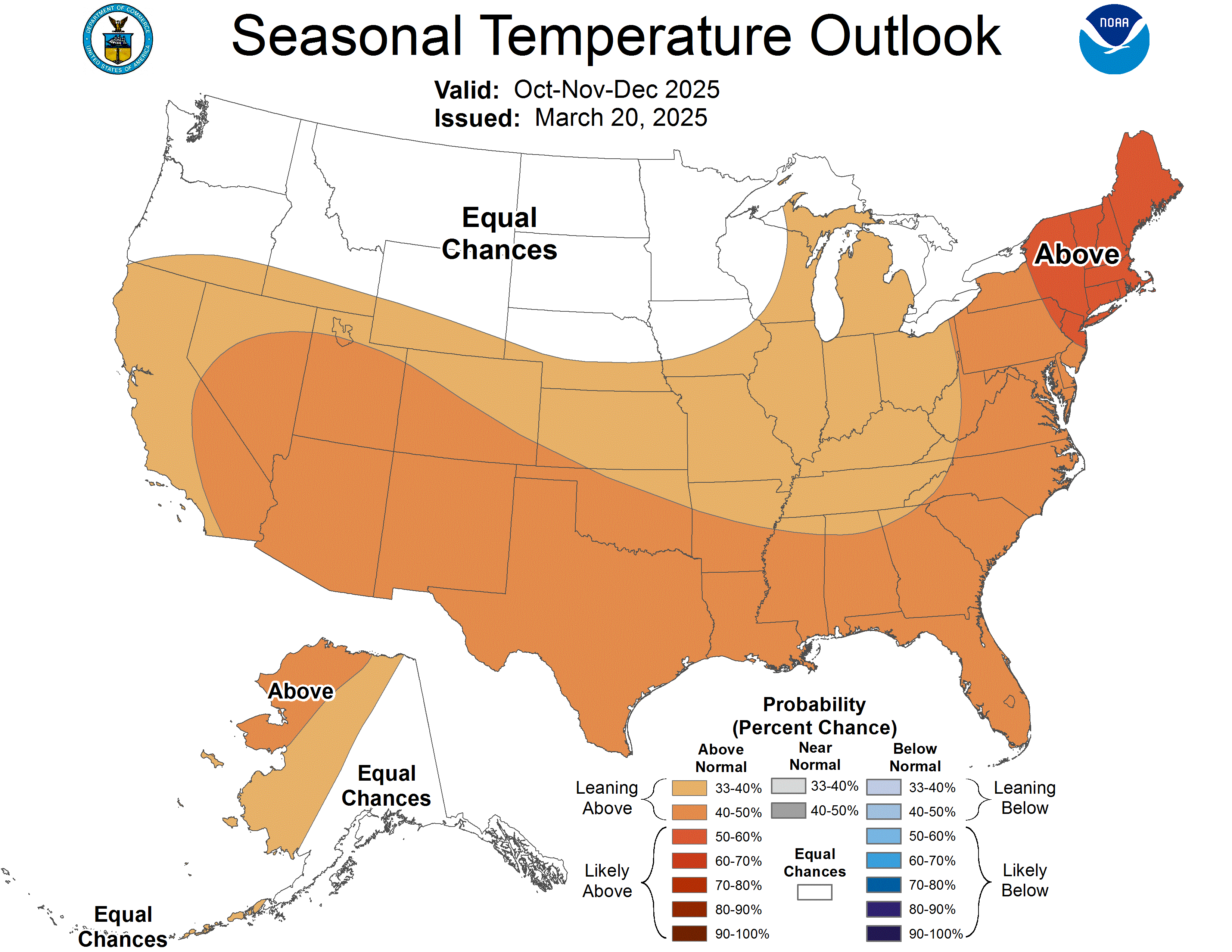

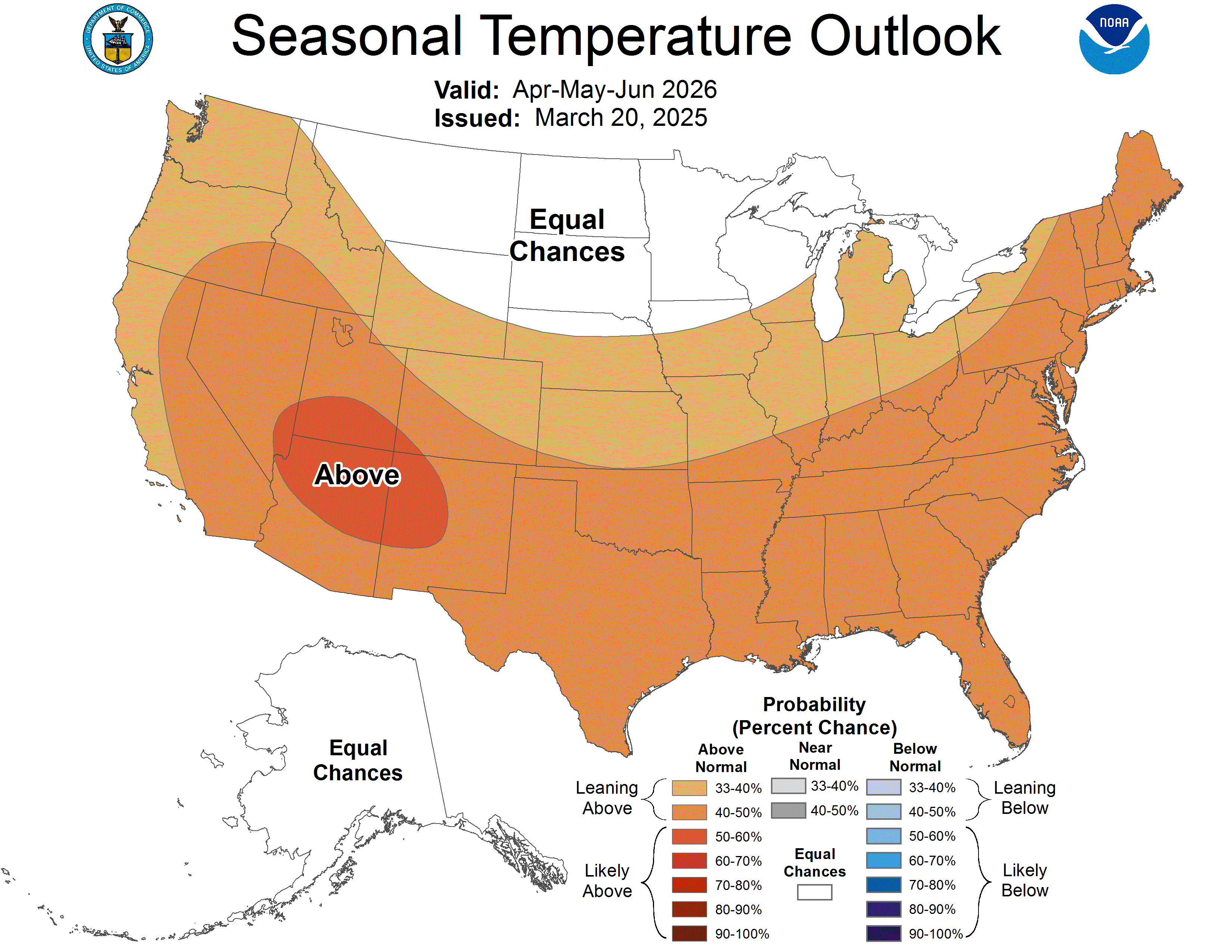
A Long Range Seasonal Temperature Outlook is a weather forecast that extends beyond the typical short-term weather predictions, covering a range of several months or an entire season. It provides valuable insights into the expected temperature patterns and trends for a specific time frame, aiding various sectors like agriculture, energy, and public health in their planning and decision-making processes.
These outlooks are typically presented in terms of temperature anomalies, which indicate whether temperatures are likely to be above, below, or near the seasonal averages. These long-range forecasts help individuals, businesses, and government agencies prepare for and adapt to anticipated temperature variations. For instance, in agriculture, farmers can plan crop planting schedules based on temperature outlooks, while energy providers can estimate demand for heating or cooling. However, it’s essential to remember that long-range outlooks are subject to uncertainties and may evolve as the season approaches and new data becomes available.

3 Months

6 Months

9 Months

12 Months

15 Months
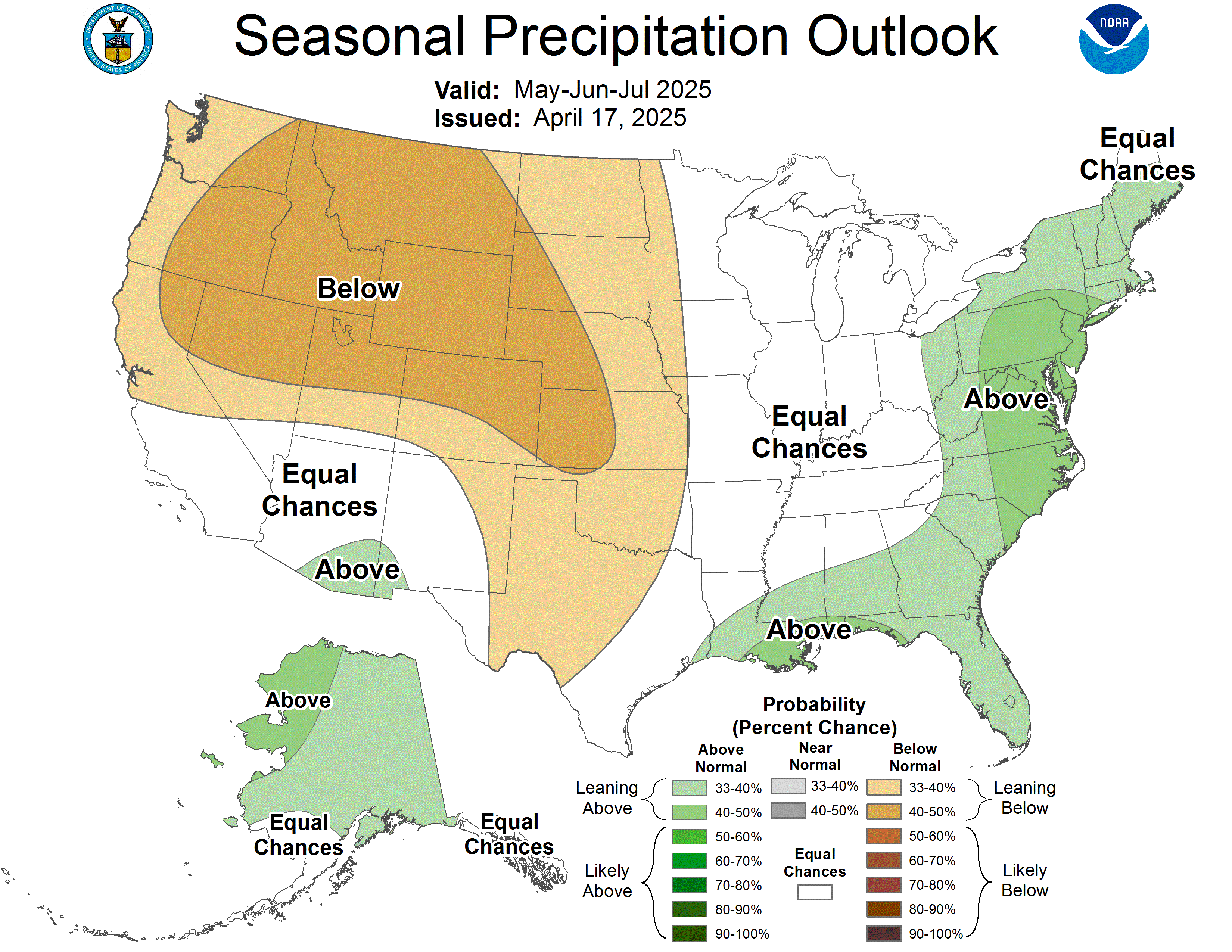
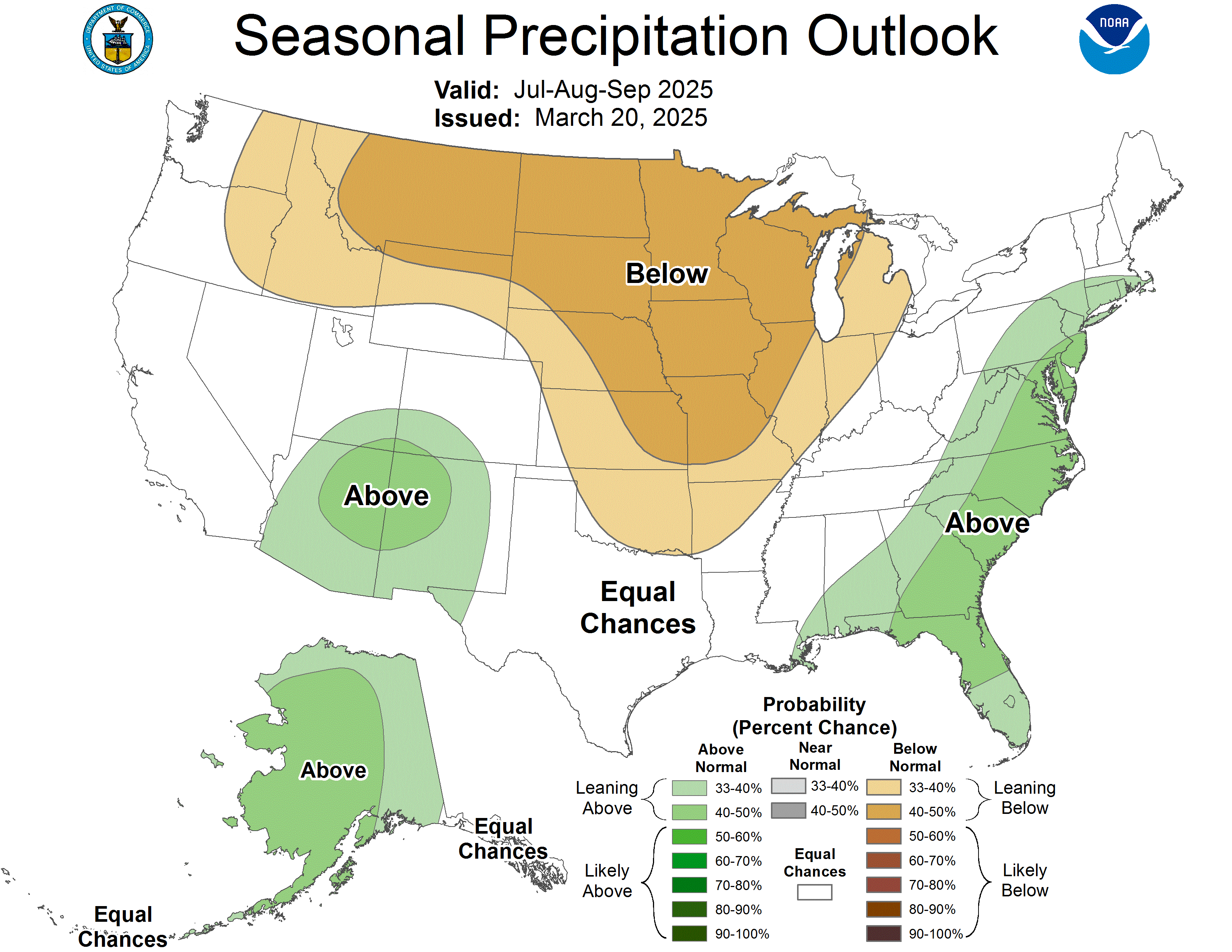
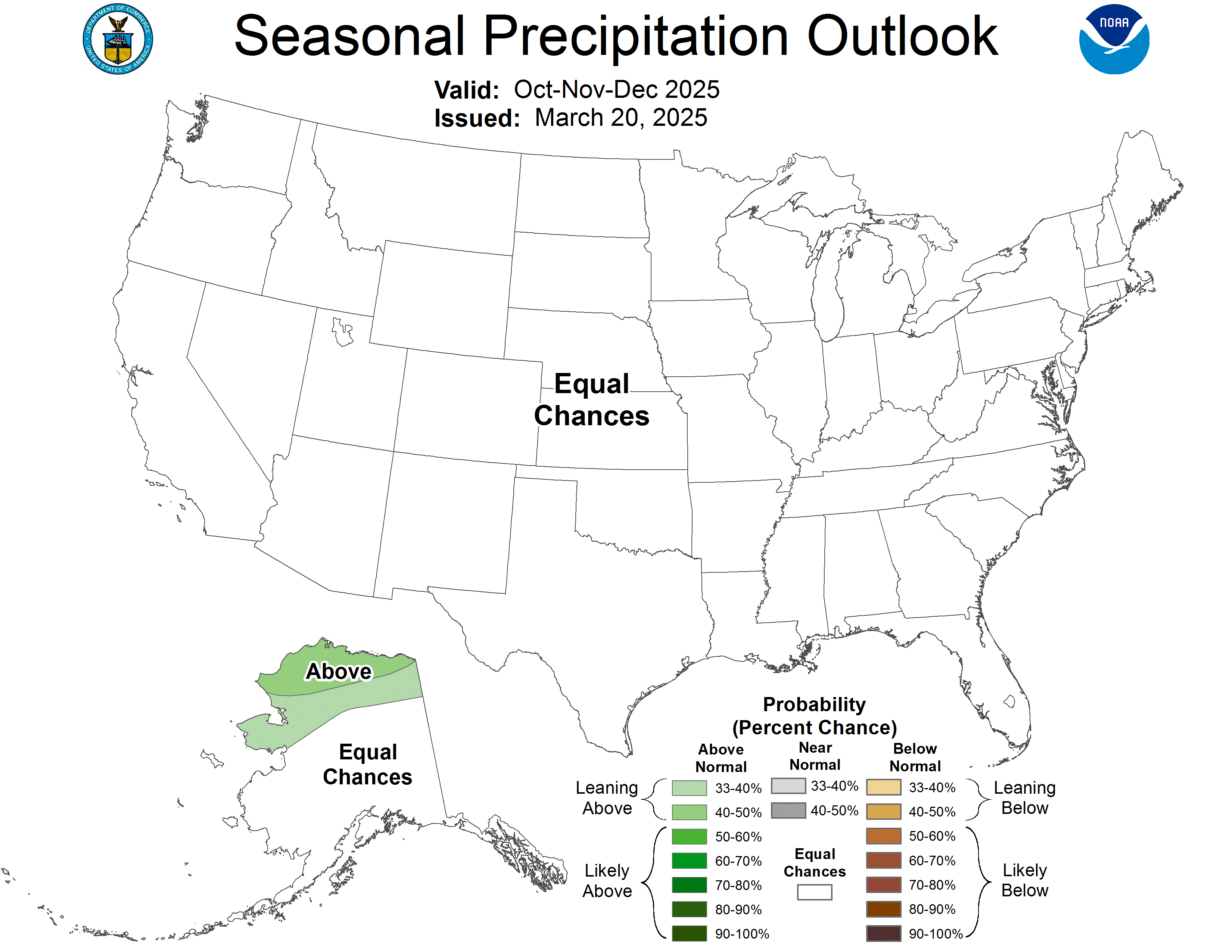
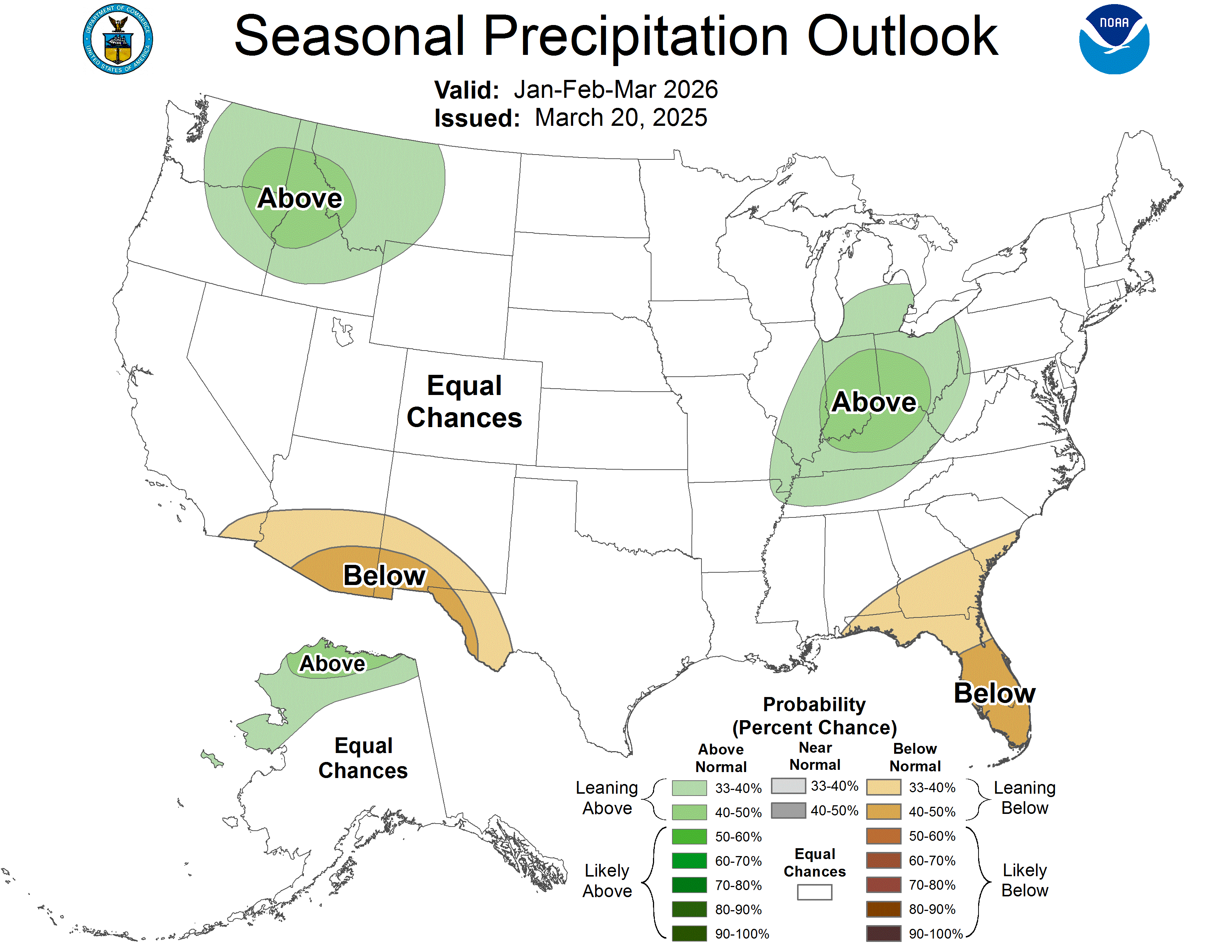
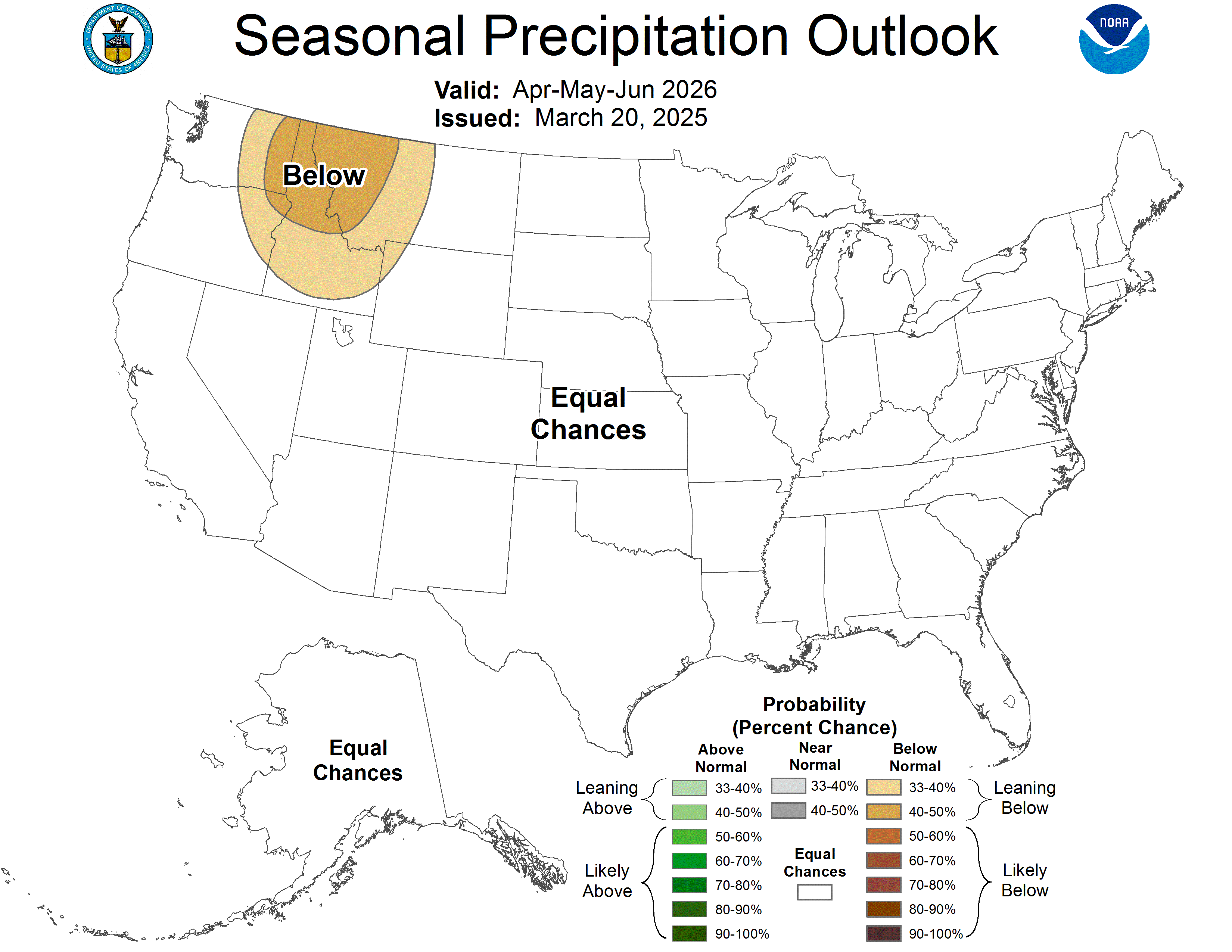
A Long Range Seasonal Precipitation Outlook is a meteorological forecast that provides an extended prediction of precipitation patterns, usually spanning several months or an entire season.
Long-range precipitation outlooks can indicate whether a region is likely to experience above-average, below-average, or near-average precipitation during a specific season. These predictions help farmers plan planting and harvesting schedules, inform drought mitigation efforts, and assist in flood preparedness. Water resource managers also rely on these outlooks to assess future water availability.
While long-range outlooks are valuable for strategic planning, they come with some level of uncertainty, especially over extended periods. Weather patterns can change, and forecasts may be subject to revisions as the season approaches and more data becomes available. Nonetheless, these outlooks serve as essential tools for managing and mitigating the impacts of varying precipitation conditions.
Weather Observations
View on the computer to see this section!

Weather Sounding

Bulk Wind Shear

SR Helicity
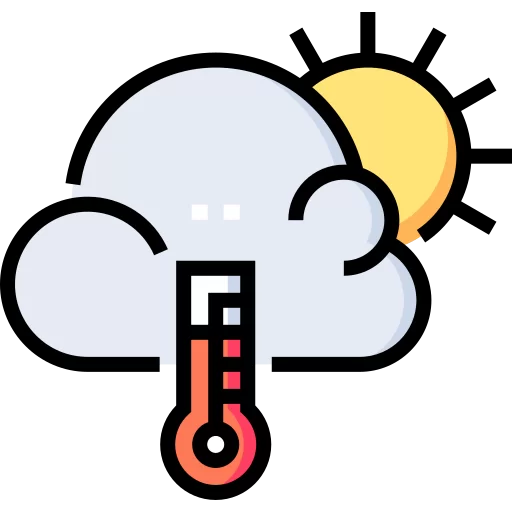
850mb Temp Advection

850mb Analysis

Surface Observations

Visible Satellite

Temp / Wind / Dewpoint
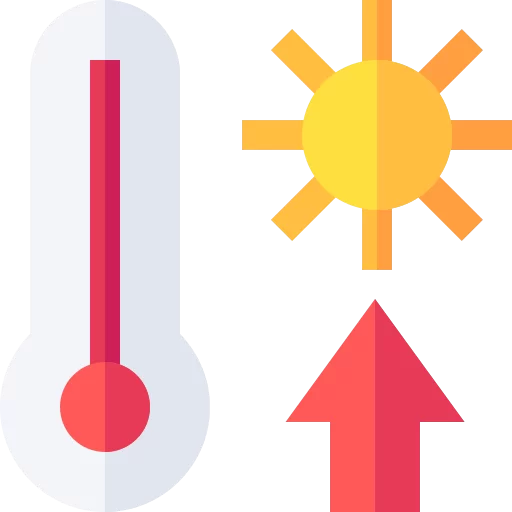
3-Hour Temperature Change
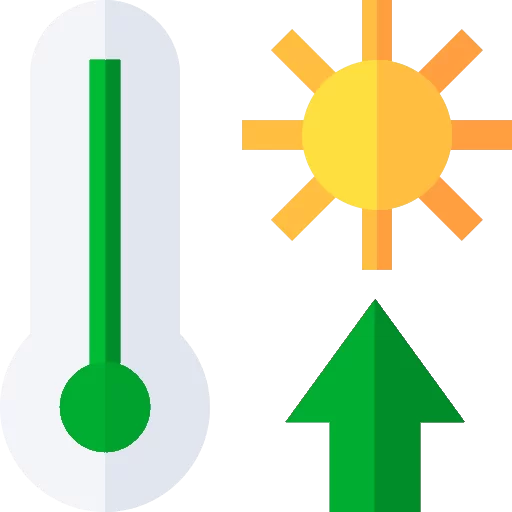
3-Hour Dewpoint Change

Drought Monitor
Weather Sounding
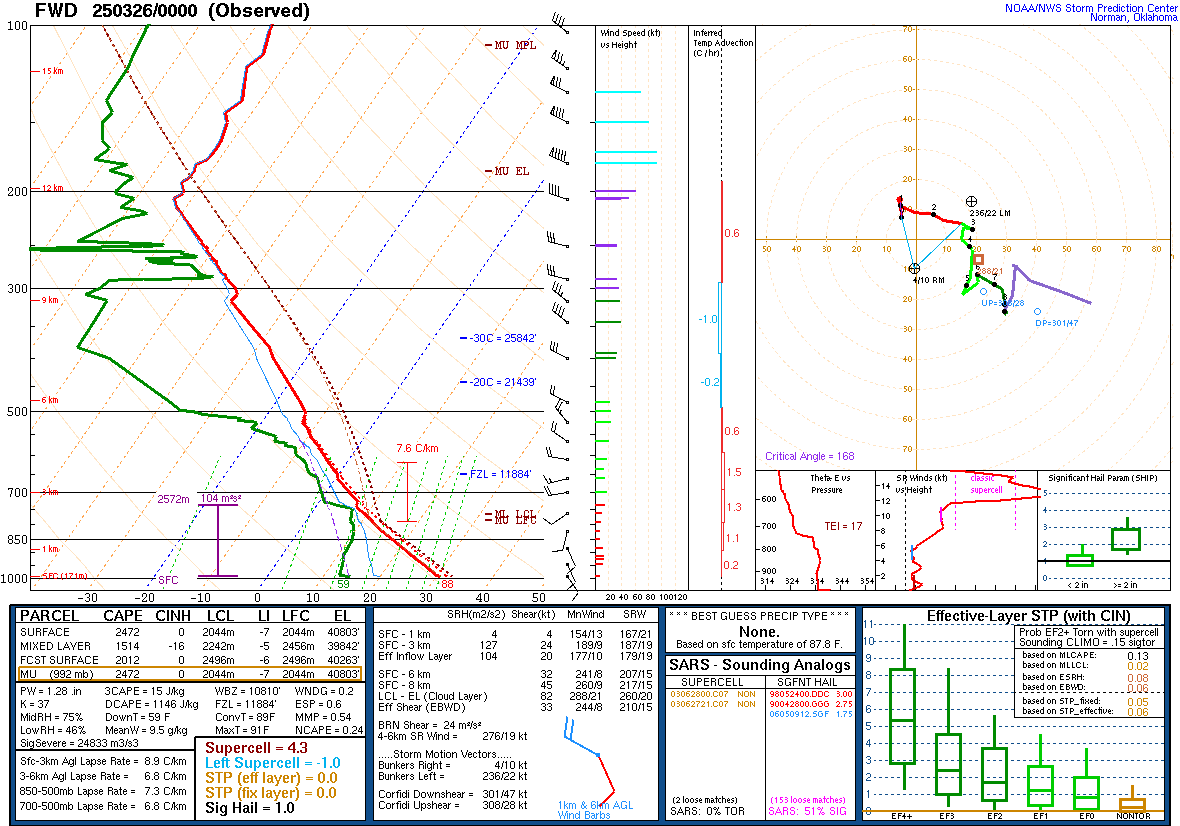
A Weather Sounding is a reading gathered by a weather balloon that creates an atmospherics profile of various kinds of weather data. These soundings (below) gather temperature, dewpoint, moisture, wind speed, wind direction, and various severe storm ingredients present in the atmosphere. All this upper-air data is gathered by radiosondes which are on weather balloons that launch at NWS offices nationwide 2-3 times daily (sometimes dependent on station). This chart may be very confusing and foreign to some. For a tutorial to understand the WC Tornado Center graph below, view WC’s page on “How to Read a Weather Sounding” (coming soon)
Some basic things to look for on a Weather Sounding for tornado forecasting would be:
- Generally high CAPE (Convective Available Potential Energy). Values around 2500+ CAPE is favorable to tornado development due to the high instability in the atmosphere. Find this value under Most Unstable CAPE (MU CAPE)
- K-Index of 26 or higher. K-Index is another method of measuring instability in the atmosphere.
- Lifted Index (LI) of less than -4. Measures the ability for a parcel to lift in the atmosphere.
- Hodograph critical angle as close to 90 degrees as possible. This indicates good wind shear for tornadoes.
- BRN Shear between 20-45 m/s.
- The red temperature line is not overlapping the brown dotted rising air parcel line down closer to the surface. If it was overlapping, it would indicate that there is Convective Inhibition (Inverse CAPE). Whenever this exists, it will prevent severe storm development and the CAPE will hold.
- SARS Sounding Analog indicating matches for SUPERCELL and SGFNT HAIL.
- Any of these categories colored orange or red: Supercell, Left Supercell, STP, and Sig Hail.
Bulk Wind Shear
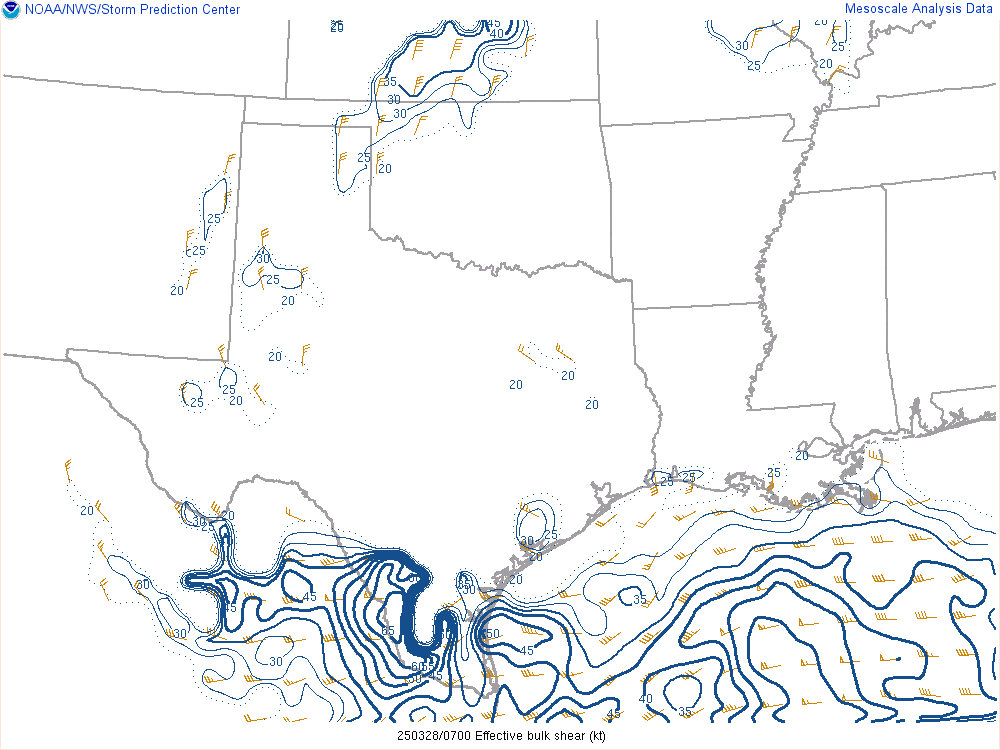
Bulk Wind Shear is the change in wind speed or direction in the lower part of the atmosphere where storm development will first develop (first 3.5 miles). This map displays the effective values. Any values 40 Knots or more is favorable environment for supercell development. The larger the number, the more shear there is which results in better potential for supercell development.
Some basic things to look for on these maps for tornado forecasting would be:
- Bulk Shear values of 40+ Knots
SR Helicity
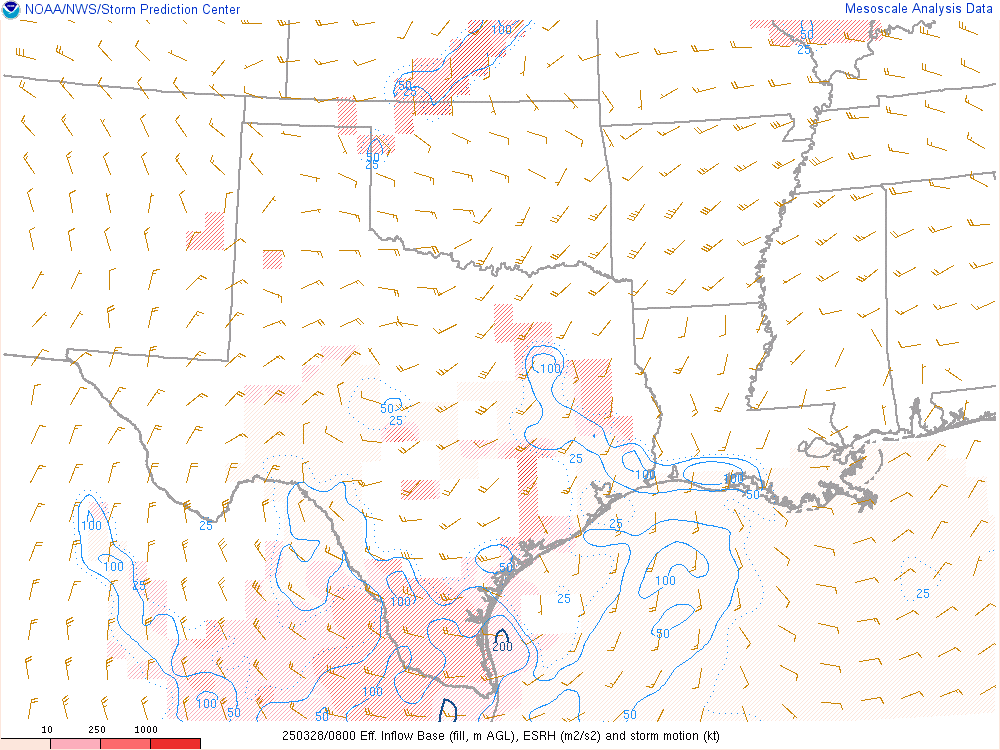
In the realm of meteorology, SR helicity, or Storm-Relative Helicity, is a critical parameter used to assess the potential for rotating updrafts within severe thunderstorms. It quantifies the relative spin in the atmosphere by considering the vertical wind shear and storm motion in a given region. High SR helicity values indicate a favorable environment for the development of supercell thunderstorms. Storm-Relative Helicity (SRH) is such a crucial parameter in that helps assess the potential for rotating updrafts in thunderstorms. SRH values provide insight into the atmosphere’s propensity for severe weather, particularly tornadoes. Here’s a general list of what different SR Helicity numbers may imply:
- Low SR Helicity (0-100 m²/s²):
- Limited or no potential for rotating updrafts.
- Thunderstorms are less likely to produce tornadoes.
- Moderate SR Helicity (100-200 m²/s²):
- A modest potential for rotating updrafts.
- Isolated tornadoes may be possible but not guaranteed.
- High SR Helicity (200-400 m²/s²):
- A significant potential for rotating updrafts.
- Conditions are favorable for supercell development and tornado formation.
- Very High SR Helicity (400 m²/s² and above):
- An extremely favorable environment for rotating updrafts.
- Increased likelihood of strong and long-lived tornadoes.
It’s important to note that SR Helicity is just one of several factors meteorologists consider when assessing severe weather potential, and its interpretation can vary depending on the specific storm and regional conditions.
850mb Temp Advection
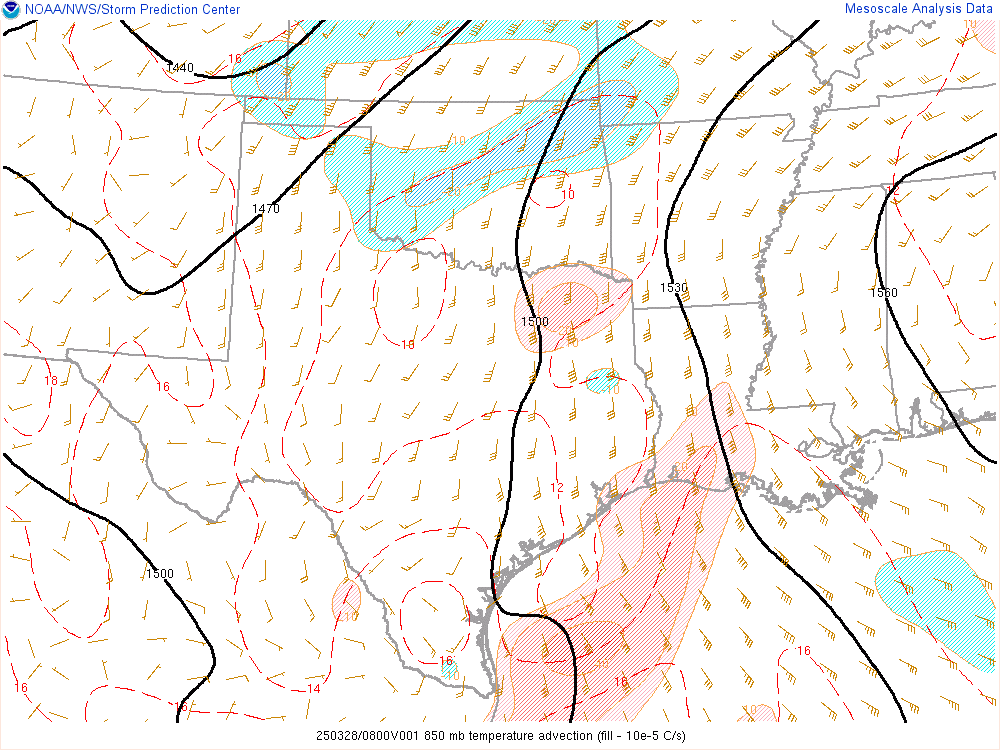
850mb Temperature Advection is a critical meteorological parameter that describes the horizontal movement of temperature changes within the atmosphere at the 850 millibar pressure level, which typically resides a few thousand feet above the Earth’s surface. This concept is indispensable for weather forecasting as it provides insights into evolving temperature patterns and their impact on local weather.
Here’s a breakdown of what different 850mb temperature advection values mean:
- Positive Advection: When positive values are observed, it indicates the horizontal transport of warmer air into an area. This results in increasing temperatures and can lead to more favorable conditions for convective processes and potentially rising temperatures.
- Negative Advection: Negative values signify the horizontal transport of cooler air into a region. This results in decreasing temperatures and can lead to cooling trends and potentially less favorable conditions for convective processes.
- Weak Advection: When the values are close to zero, it suggests minimal temperature changes and relatively stable weather conditions.
- Strong Advection: Large positive or negative values imply significant temperature variations are expected. This can indicate more dynamic weather patterns, including the potential for temperature-driven weather events like thunderstorms or temperature drops leading to cold fronts.
Meteorologists rely on 850mb temperature advection to anticipate temperature-related weather changes, helping in the accuracy of weather forecasts and climate analysis.
850mb Analysis
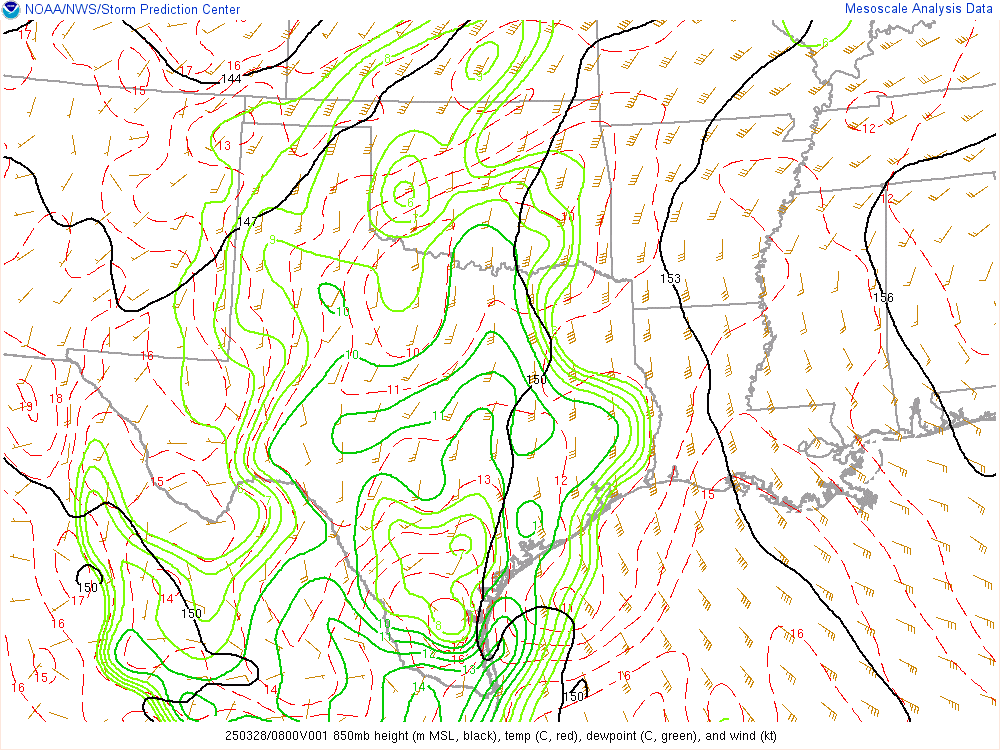
850mb analysis, in meteorology, refers to the examination and interpretation of various atmospheric parameters at the 850 millibar pressure level, which typically occurs several thousand feet above the Earth’s surface. This analysis is instrumental in weather forecasting, offering critical insights into atmospheric conditions. Here’s a list of number values associated with 850mb analysis and their implications:
- Temperature (in degrees Celsius):
- Positive values suggest warmer air at that level.
- Negative values indicate cooler air.
- Dew Point (in degrees Celsius):
- A higher dew point suggests more moisture at this level.
- A lower dew point indicates drier air.
- Wind Speed (in knots):
- Wind speed and direction provide information about horizontal wind flow, influencing weather systems.
- Relative Humidity (as a percentage):
- High values suggest more saturated air.
- Low values indicate drier conditions.
Meteorologists use 850mb analysis to assess temperature, moisture, and wind patterns, aiding in the identification of weather systems, the development of precipitation, and the prediction of weather trends. It’s a valuable tool for understanding the vertical structure of the atmosphere and forecasting various weather events.
Surface Observations
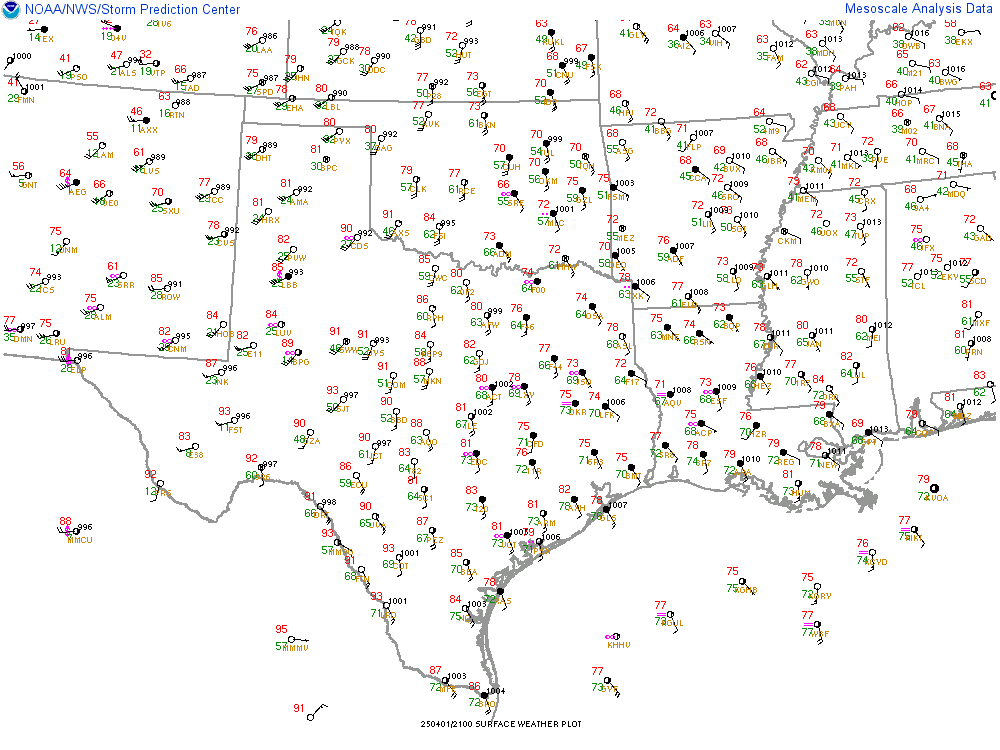
Surface observations refer to the collection of real-time weather data at or near the Earth’s surface. These data are crucial for weather forecasting, climate analysis, and monitoring local weather conditions. Surface observations typically include the following key parameters:
- Temperature (in degrees Celsius): The current air temperature provides information about how hot or cold it is at a specific location.
- Dew Point (in degrees Celsius): The dew point temperature indicates the air’s moisture content, with higher values signifying more humidity.
- Wind Speed (in knots or miles per hour): Wind speed and direction offer insights into the movement of air, influencing weather patterns.
- Relative Humidity (as a percentage): Relative humidity measures the air’s moisture content concerning its capacity to hold moisture, with higher values suggesting more saturation.
- Barometric Pressure (in hPa or mb): Barometric pressure reveals the weight of the atmosphere at a particular location and helps identify high or low-pressure systems.
- Precipitation (in inches or millimeters): Precipitation data record the amount of rain, snow, or other forms of moisture falling to the ground.
- Visibility (in miles or meters): Visibility describes how far one can see due to atmospheric conditions like fog, rain, or snow.
Meteorologists utilize surface observations from weather stations, weather balloons, and other instruments to understand local weather conditions, track weather systems, and issue accurate forecasts and warnings. These observations provide valuable information for daily weather reports and long-term climate studies.
Visible Satellite

The Visible Satellite is a weather observation tool that captures images of the Earth’s surface and cloud cover in the visible spectrum of light. It’s a valuable resource for meteorologists and weather enthusiasts, aiding in the monitoring and analysis of weather systems and conditions. Here’s a list of number values associated with Visible Satellite imagery and what they signify:
- Brightness Temperature (in degrees Celsius): The brightness temperature is derived from the satellite’s sensor data and can indicate cloud cover and surface temperature. Lower values are often associated with cooler surfaces.
- Reflectance Values (in percentages): These values represent the amount of sunlight reflected by various surfaces, including land, water, and clouds. High values indicate highly reflective surfaces like snow or ice.
- Cloud Cover (in percentages): The extent of cloud cover, often categorized as clear, partly cloudy, or overcast, is determined by analyzing the brightness and texture of cloud formations.
- Daylight/Darkness: Visible satellite imagery is only available during daylight hours, so it provides information on the presence of daylight or darkness at a given time.
Meteorologists use Visible Satellite data to monitor weather phenomena such as cloud patterns, storm development, and the movement of weather systems. It’s an essential tool for tracking real-time weather conditions and assisting in the preparation and issuance of weather forecasts and warnings.
Temp / Wind / Dewpoint
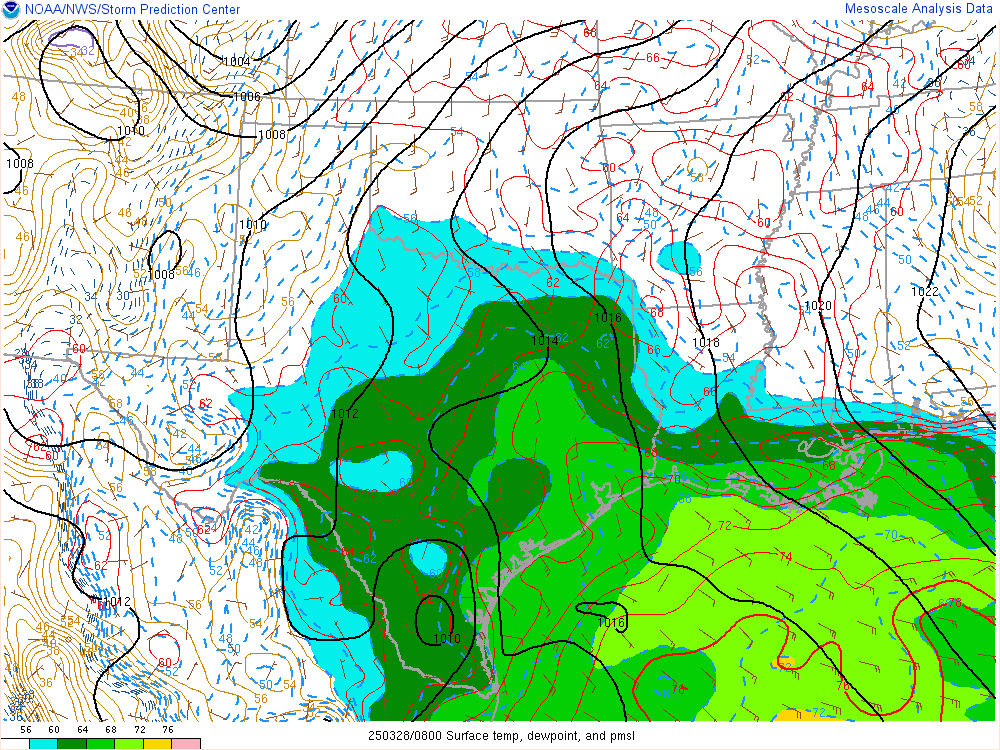
Temperature, wind, and dew point analysis involves the assessment of these fundamental weather parameters to understand atmospheric conditions and their impact on local weather. Here’s a list of number values associated with these analyses and their interpretations:
- Temperature (in degrees Celsius or Fahrenheit):
- High values indicate warmer conditions, while low values suggest cooler weather.
- Rapid temperature changes can signify the approach of a weather front or other dynamic atmospheric conditions.
- Wind Speed (in knots or miles per hour):
- Low wind speeds suggest calm conditions, while high speeds indicate stronger winds.
- Wind direction provides insights into the origin of air masses and potential weather patterns.
- Dew Point (in degrees Celsius or Fahrenheit):
- A high dew point indicates higher humidity levels and a more uncomfortable, muggy environment.
- A low dew point signifies drier air and can be associated with clearer skies.
Meteorologists use these analyses to gauge the state of the atmosphere, identify the potential for weather systems such as cold fronts, warm fronts, and the likelihood of precipitation, and provide essential information for weather forecasting. Monitoring these values helps meteorologists make accurate predictions, issue warnings, and inform the public about current and impending weather conditions.
3-Hour Temperature Change
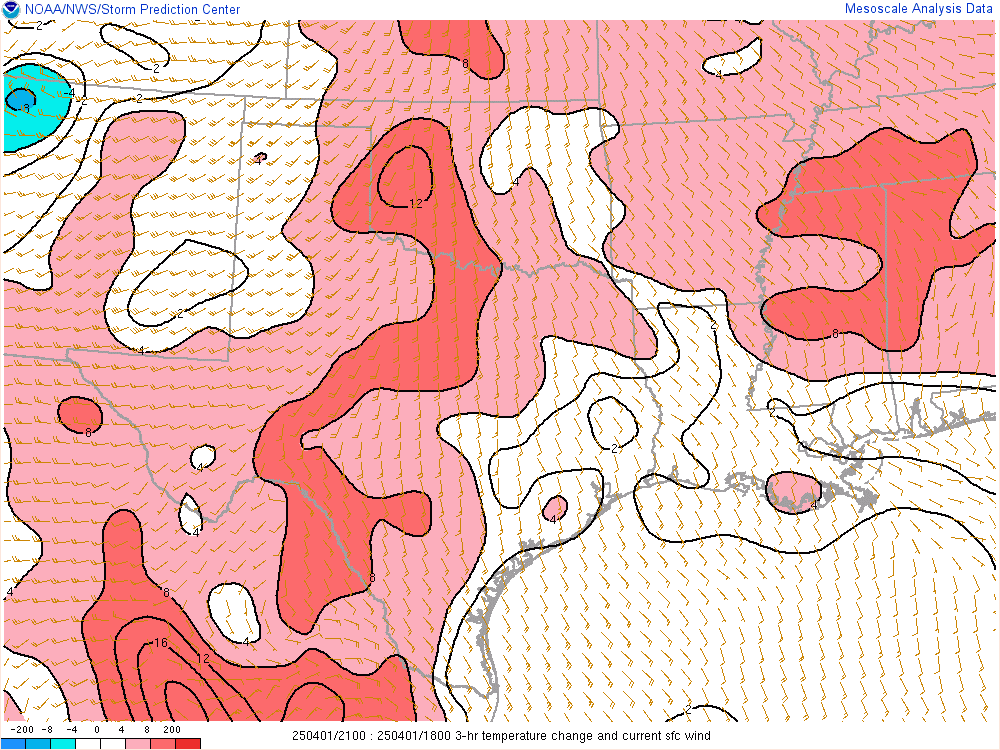
The 3-hour temperature change analysis is a crucial tool used to assess how rapidly temperatures are shifting over a specific period, typically within a three-hour timeframe. It plays a vital role in weather monitoring and forecasting. Here’s a list of number values associated with 3-hour temperature change and their implications:
- Positive Change (in degrees Celsius or Fahrenheit):
- A positive value indicates that temperatures have risen over the past three hours.
- It suggests a warming trend and may be linked to improving weather conditions.
- Negative Change (in degrees Celsius or Fahrenheit):
- A negative value signifies a drop in temperatures during the past three hours.
- It implies a cooling trend and may be associated with deteriorating weather conditions, like the arrival of a cold front.
- Zero Change (0 degrees Celsius or Fahrenheit):
- A value of zero suggests little to no change in temperature over the specified time frame.
Meteorologists use the 3-hour temperature change analysis to track short-term temperature variations, identify the influence of passing weather systems, and assess the potential for rapidly changing weather conditions. This information aids in making timely forecasts and providing valuable insights to the public and various industries.
3-Hour Dewpoint Change
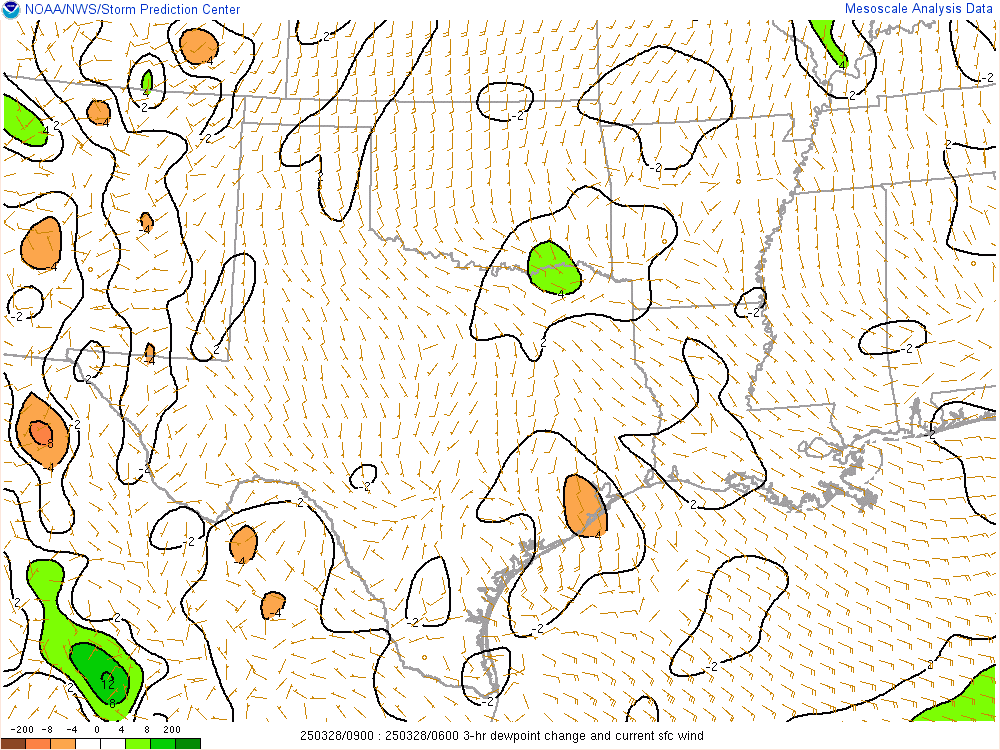
The 3-hour dew point change analysis is a tool used to evaluate how quickly dew point temperatures have altered over a three-hour timeframe. Dew point is a measure of humidity, and this analysis is vital for understanding changes in atmospheric moisture and their impact on weather conditions. Here’s a list of number values associated with the 3-hour dew point change and their interpretations:
- Positive Change (in degrees Celsius or Fahrenheit):
- A positive value indicates an increase in dew point temperature over the past three hours.
- It signifies a rise in humidity, potentially leading to more uncomfortable or muggy conditions.
- Negative Change (in degrees Celsius or Fahrenheit):
- A negative value suggests a decrease in dew point temperatures within the last three hours.
- It indicates a reduction in humidity and the potential for drier, more comfortable conditions.
- Zero Change (0 degrees Celsius or Fahrenheit):
- A value of zero signifies little to no change in dew point temperature over the specified time frame.
Meteorologists use the 3-hour dew point change analysis to monitor shifts in atmospheric moisture, identify the influence of weather systems, and predict changes in weather patterns. Understanding dew point changes is crucial for forecasting the potential for precipitation, heat stress, and comfort levels for various outdoor activities.
Drought Monitor
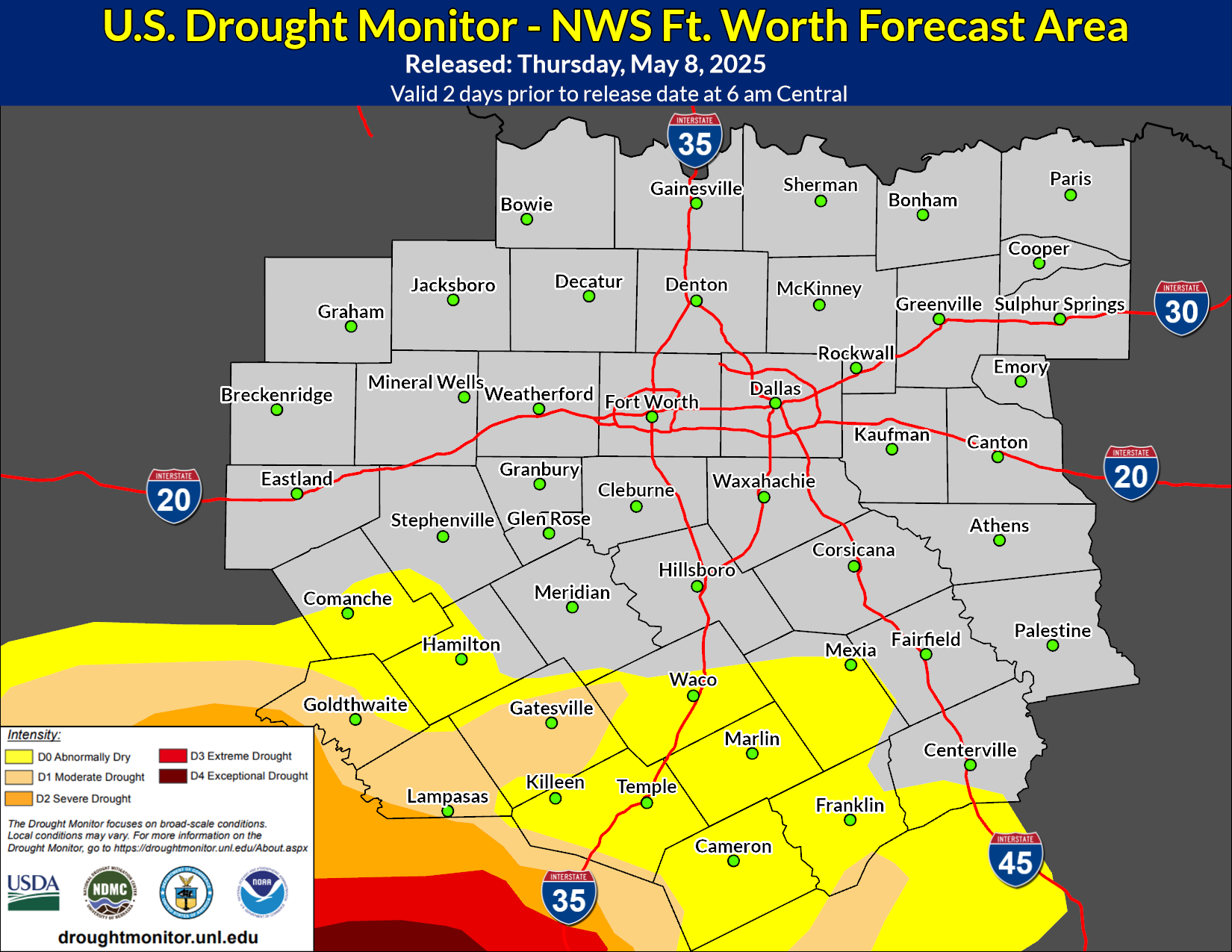
The Drought Monitor is a tool that assesses and communicates the extent and severity of drought conditions across various regions, aiding in the management of water resources, agriculture, and public safety. It relies on a combination of data and expert analysis to categorize drought severity, ranging from abnormally dry to exceptional drought. Here’s a list of number values associated with the Drought Monitor and what they signify:
- D0 (Abnormally Dry):
- Slightly drier than usual conditions with short-term dryness.
- May signal the early stages of drought.
- D1 (Moderate Drought):
- Continued dryness leading to reduced water supply and stress on crops and ecosystems.
- Increased potential for water use restrictions.
- D2 (Severe Drought):
- Widespread water shortages, with major crop and pasture losses.
- Imminent water use restrictions and potentially damaging impacts on ecosystems.
- D3 (Extreme Drought):
- Major water deficits, widespread crop and pasture loss, and water emergencies.
- Significant water use restrictions and threats to water supplies.
- D4 (Exceptional Drought):
- Exceptional and widespread water shortages, devastating impacts on agriculture, and severe water emergencies.
- High likelihood of catastrophic water supply and ecosystem damage.
The Drought Monitor helps authorities and the public understand the evolving drought conditions and take necessary actions to mitigate its effects, such as water conservation, crop management, and disaster response.
Severe Weather Analysis
View on the computer to see this section!

Surface Based CAPE

3-Hour CAPE Change

Supercell Composite

LCL Height

Total Totals

K-Index

Critical Angle

Energy-Helicity Index

Showalter Index

Significant Hail Chance

SARS Hail Size
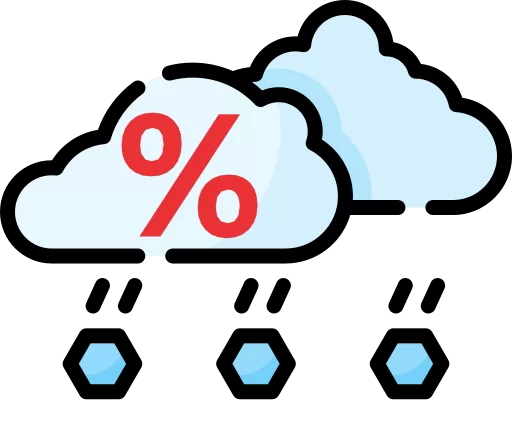
SARS Significant Hail %

Significant Tornado

Probability of EF0+

Probability of EF2+

Probability of EF4+
Surface Based CAPE
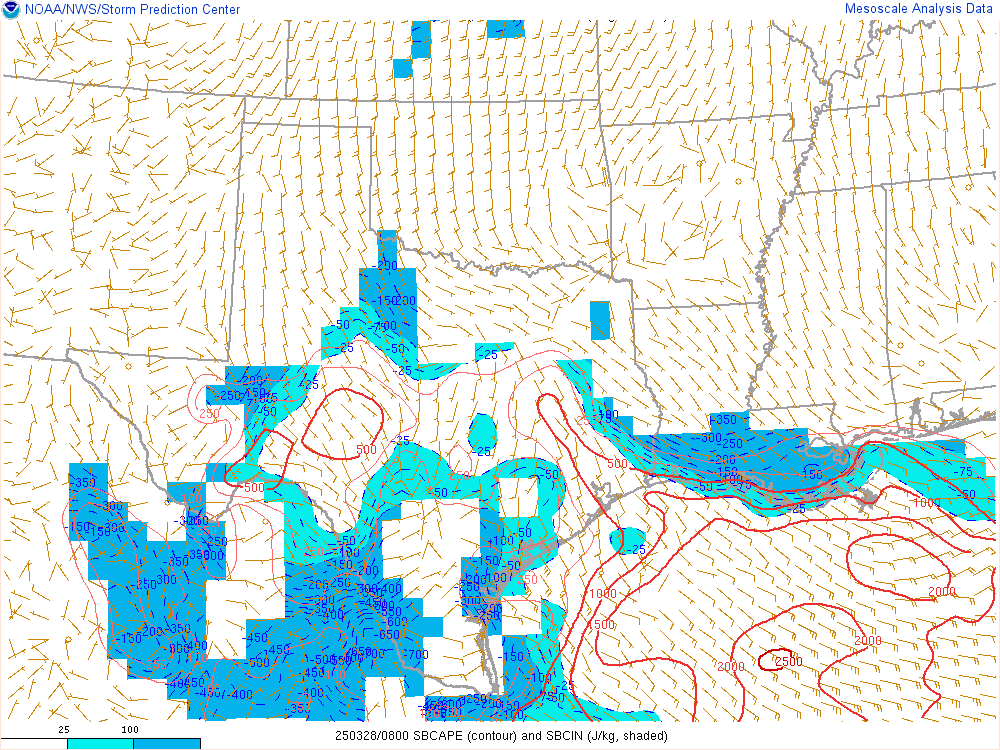
Surface-Based CAPE, or Convective Available Potential Energy, is a term used to quantify the amount of atmospheric energy available for convective thunderstorm development near the Earth’s surface. It is a key parameter for assessing the potential for severe weather, particularly thunderstorms. Surface-Based CAPE values are expressed in joules per kilogram (J/kg), and they provide insight into the instability and likelihood of storm development. Here’s a list of number values associated with Surface-Based CAPE and their interpretations:
- Low CAPE (0-500 J/kg):
- Limited potential for strong or severe thunderstorm development.
- Typically results in less intense convective activity.
- Moderate CAPE (500-1,000 J/kg):
- Favorable for thunderstorms with the potential for heavy rain, lightning, and gusty winds.
- Severe weather is possible but less likely.
- High CAPE (1,000-2,500 J/kg):
- Indicates a substantial potential for severe thunderstorms with intense updrafts.
- Increased risk of severe weather, including large hail, damaging winds, and tornadoes.
- Very High CAPE (2,500 J/kg and above):
- Suggests an extremely unstable atmosphere, with a high potential for severe weather events, including supercells and violent thunderstorms.
Surface-Based CAPE is a valuable tool for meteorologists to assess the atmospheric conditions conducive to thunderstorm development and the potential for severe weather.
3-Hour CAPE Change
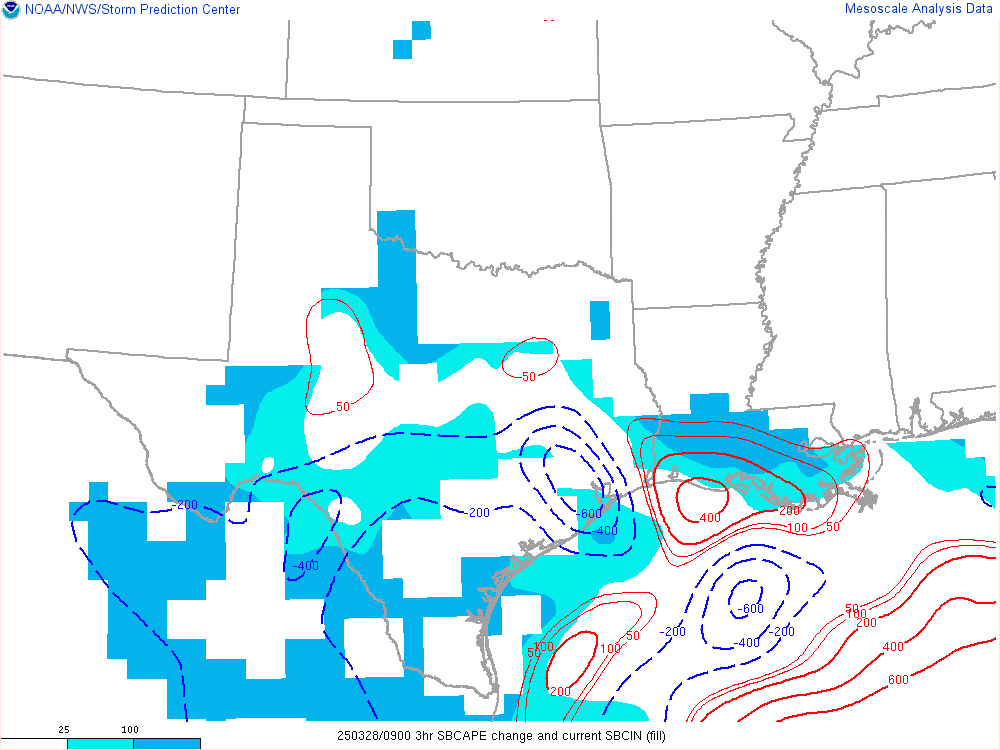
3-hour CAPE change refers to the assessment of Convective Available Potential Energy (CAPE) over a three-hour time frame. CAPE is a critical meteorological parameter that quantifies the atmospheric energy available for the development of thunderstorms. A change in CAPE over a short period can indicate significant shifts in atmospheric instability, which is crucial for forecasting severe weather. Here’s a list of number values associated with 3-hour CAPE change and their implications:
- Positive Change (in joules per kilogram, J/kg):
- A positive value indicates an increase in CAPE over the past three hours.
- Suggests growing atmospheric instability, raising the potential for thunderstorm development.
- Negative Change (in J/kg):
- A negative value signifies a decrease in CAPE within the last three hours.
- Indicates a reduction in atmospheric instability and a potential decline in the likelihood of thunderstorms.
- Zero Change (0 J/kg):
- A value of zero implies little to no change in CAPE during the specified time frame.
Meteorologists use 3-hour CAPE change to monitor the dynamic nature of atmospheric instability and its impact on thunderstorm development. Significant changes can influence the severity of weather events, including the likelihood of severe storms, hail, and tornadoes.
Supercell Composite
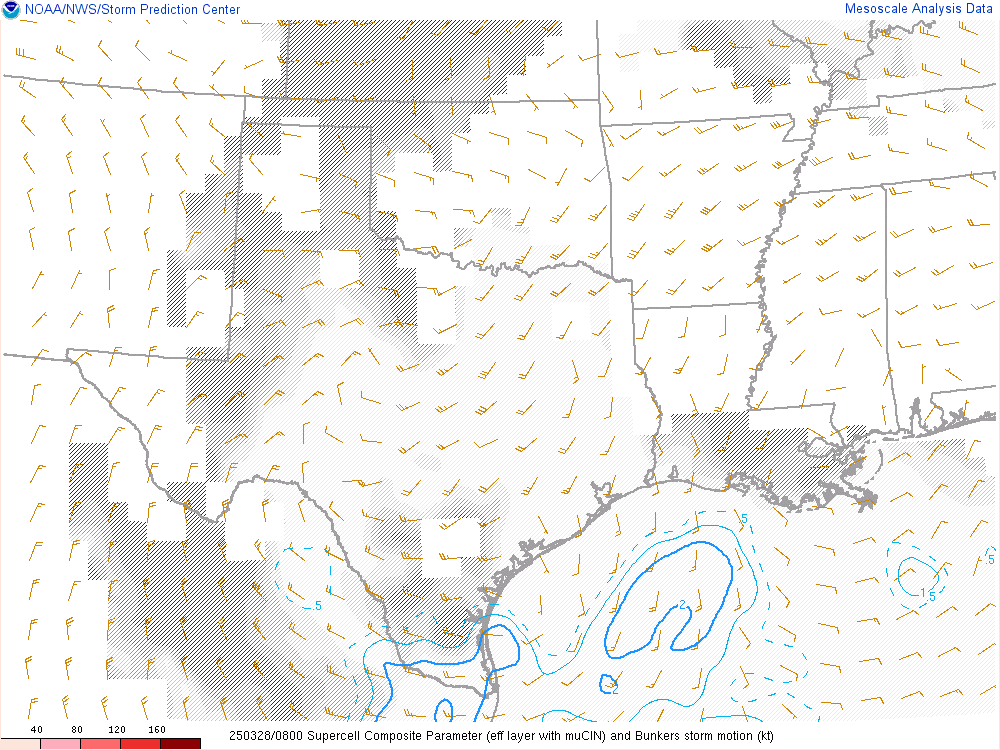
The Supercell Composite is an index designed to assess the potential for supercell thunderstorm development. Supercells are severe thunderstorms characterized by rotating updrafts, often associated with tornadoes, large hail, and damaging winds. This index combines various atmospheric parameters to gauge the likelihood of supercell formation. Here’s a list of number values associated with the Supercell Composite and their interpretations:
- Low Value (0-1):
- Suggests a low likelihood of supercell thunderstorms.
- Typically indicates less favorable conditions for severe weather.
- Moderate Value (1-3):
- A moderate potential for supercell development.
- Indicates the possibility of severe weather with rotating updrafts.
- High Value (3-6):
- Suggests a significant potential for supercell thunderstorms.
- Indicates a heightened risk of severe weather events, including tornadoes.
- Very High Value (6 and above):
- Signifies an extremely favorable environment for supercell development.
- Suggests a high risk of severe weather, often with strong and long-lived tornadoes.
Meteorologists rely on the Supercell Composite to anticipate and monitor conditions conducive to supercell thunderstorms, enhancing the accuracy of severe weather forecasts and helping to issue timely warnings.
LCL Height
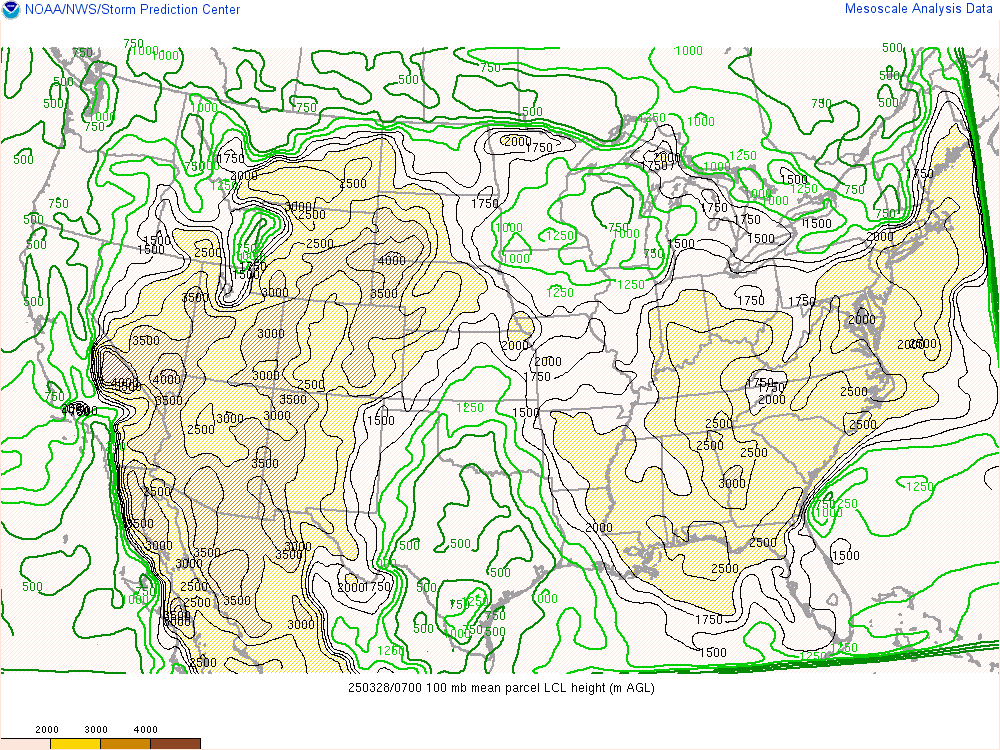
The Lifted Condensation Level (LCL) Height is a critical parameter that helps in assessing cloud base heights and the potential for cloud formation. It represents the altitude at which a parcel of moist air, when lifted, cools to the point where its relative humidity reaches 100%, and condensation occurs, forming clouds. LCL height is vital for forecasting and understanding cloud development and weather patterns. Here’s a list of number values associated with LCL height and their implications:
- Low LCL Height (below 1,000 meters):
- Suggests cloud formation and potential for low-level clouds.
- Often related to localized weather phenomena and cooler conditions near the surface.
- Moderate LCL Height (1,000-2,500 meters):
- Typical for the development of mid-level clouds.
- Often associated with more stable and less convective atmospheric conditions.
- High LCL Height (above 2,500 meters):
- Signifies cloud formation at higher altitudes.
- Indicates potential for convective storms, towering cumulus clouds, and more dynamic atmospheric conditions.
Meteorologists use LCL height to gauge the altitude at which cloud bases and potential precipitation events may occur, aiding in weather forecasting and understanding vertical atmospheric structure.
Total Totals
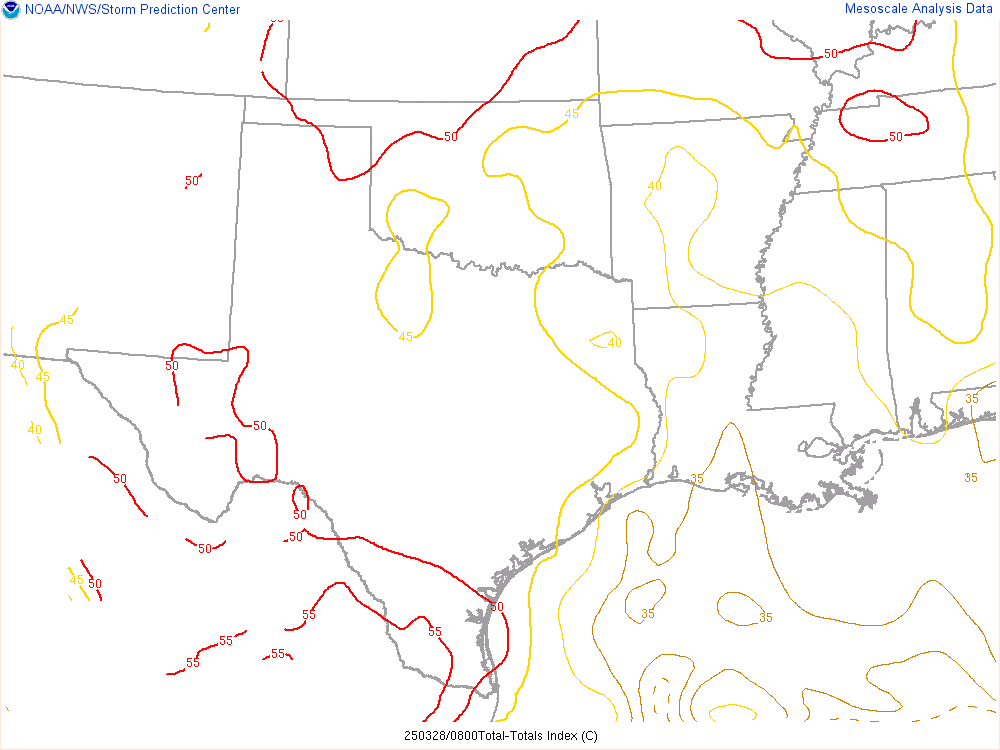
Total Totals (TT) is an index used to assess atmospheric instability and the potential for severe weather, especially convective storms. It is calculated by adding two temperature values and subtracting the dew point temperature. TT values help meteorologists determine the likelihood of thunderstorm development and severe weather. Here’s a list of number values associated with Total Totals and their interpretations:
- Low TT (below 40):
- Indicates limited atmospheric instability and a lower potential for severe weather.
- Suggests a lower likelihood of intense thunderstorms.
- Moderate TT (40-50):
- Suggests a moderate level of atmospheric instability.
- A moderate chance of thunderstorm development, potentially leading to strong storms.
- High TT (50-55):
- Signifies a higher level of atmospheric instability.
- An increased potential for severe weather events, including strong thunderstorms.
- Very High TT (above 55):
- Indicates an extremely unstable atmosphere with a significant potential for severe weather.
- Suggests a high likelihood of severe storms, including hail, strong winds, and possible tornadoes.
Meteorologists use Total Totals to assess the degree of atmospheric instability, helping to predict and monitor the potential for severe weather and thunderstorm development.
K-Index
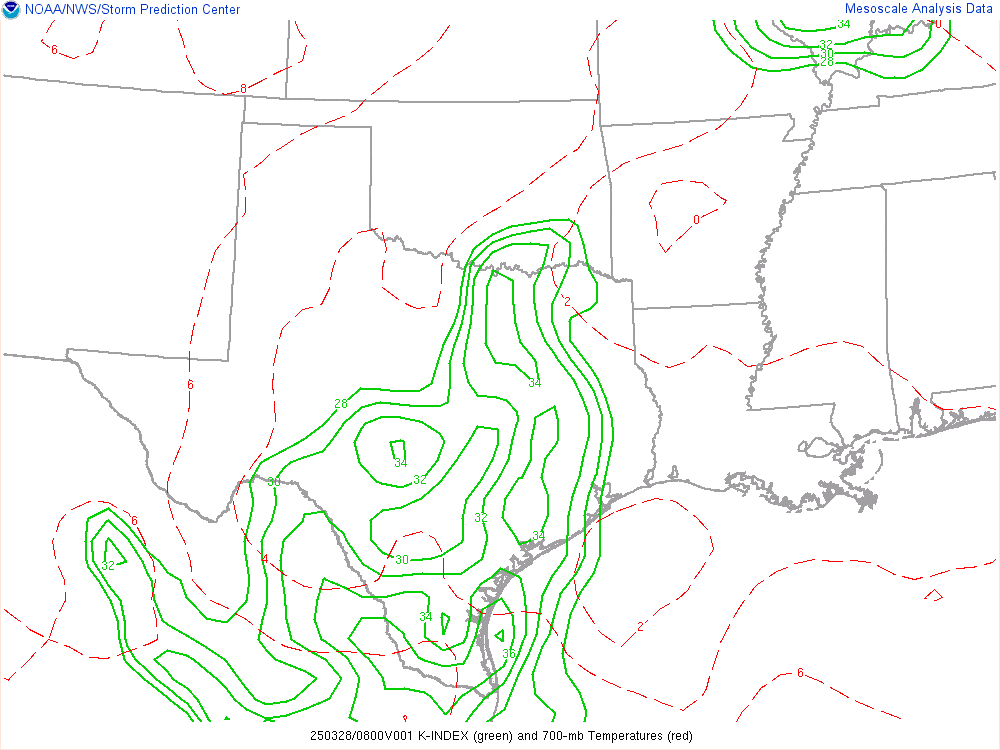
The K-index is a valuable parameter used to evaluate atmospheric stability and the potential for thunderstorm development. It helps meteorologists assess the likelihood of severe weather and provides crucial information for weather forecasting. The K-index combines various atmospheric measurements to gauge atmospheric instability, including temperature, dew point, and wind data. Here’s a list of number values associated with the K-index and their implications:
- Low K-index (0-15):
- Indicates a stable atmosphere with limited potential for thunderstorms.
- Suggests relatively calm and benign weather conditions.
- Moderate K-index (15-25):
- Signifies a moderately unstable atmosphere with a moderate potential for thunderstorm development.
- Suggests a chance of scattered or non-severe thunderstorms.
- High K-index (25-35):
- Indicates a higher level of atmospheric instability.
- Suggests an increased likelihood of severe weather, including strong thunderstorms.
- Very High K-index (above 35):
- Signifies an extremely unstable atmosphere.
- Predicts a high likelihood of severe weather events, such as large hail, damaging winds, and tornadoes.
The K-index is a critical tool for meteorologists as it helps in identifying regions of potential convective activity and severe weather, especially when combined with other meteorological indices. High K-index values are often associated with warm, moist air masses, which provide the necessary conditions for strong thunderstorm development. By monitoring the K-index, meteorologists can issue timely warnings and advisories to keep the public informed and safe during severe weather events.
Critical Angle
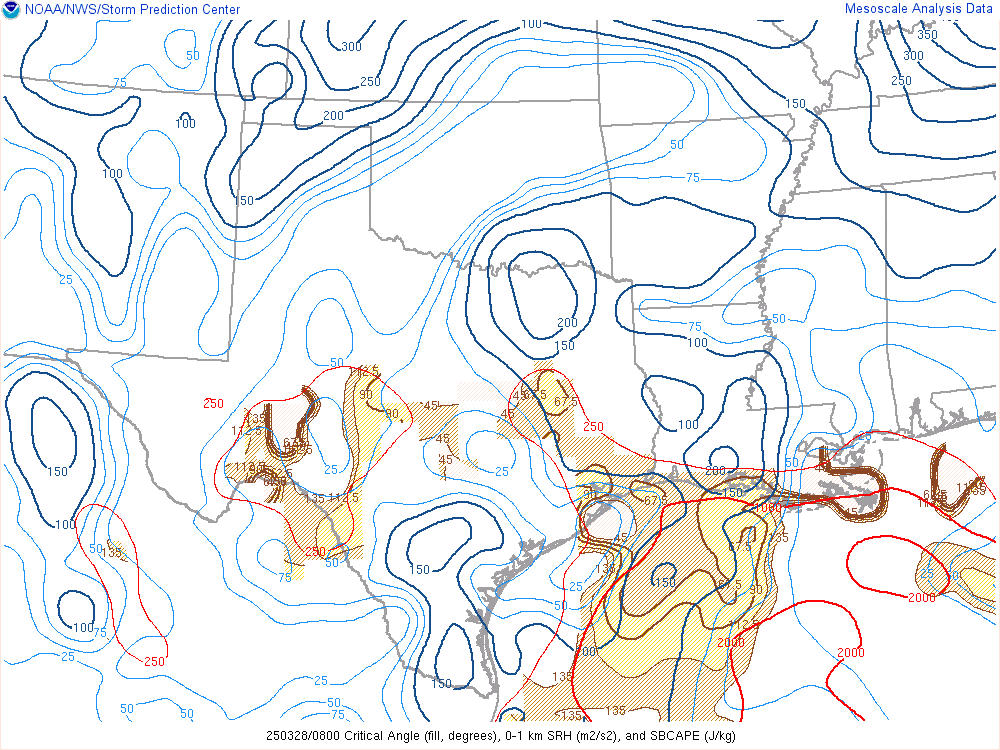
The Critical Angle refers to the angle at which a low-level wind approaching an area of severe weather must intersect with storm motion to maximize the potential for supercell thunderstorm development and tornado formation. This concept is essential for understanding atmospheric conditions conducive to severe weather and tornadoes. Here’s a list of number values associated with the Critical Angle and their implications:
- Small Critical Angle (0-30 degrees):
- A small angle suggests that low-level winds are nearly aligned with the storm’s motion.
- This configuration can enhance the potential for supercell thunderstorms and increase the risk of tornadoes.
- Moderate Critical Angle (30-60 degrees):
- A moderate angle indicates that low-level winds approach the storm at an angle.
- This scenario offers a reasonable chance for supercell development and tornadoes but may not be as conducive as a smaller critical angle.
- Large Critical Angle (60-90 degrees):
- A large critical angle suggests that low-level winds intersect the storm’s motion at a significant angle.
- This configuration is less favorable for supercell and tornado development.
The Critical Angle is a key tool in meteorology, particularly when assessing the likelihood of severe weather events. When the critical angle is small, it signifies a more favorable environment for supercells and tornadoes, as the winds are better aligned to enhance storm rotation and updrafts. Meteorologists use this parameter to issue warnings and advisories, helping communities prepare for potentially dangerous weather conditions. Understanding the critical angle is crucial in improving the accuracy of weather forecasts and increasing the lead time for tornado warnings.
Energy-Helicity Index
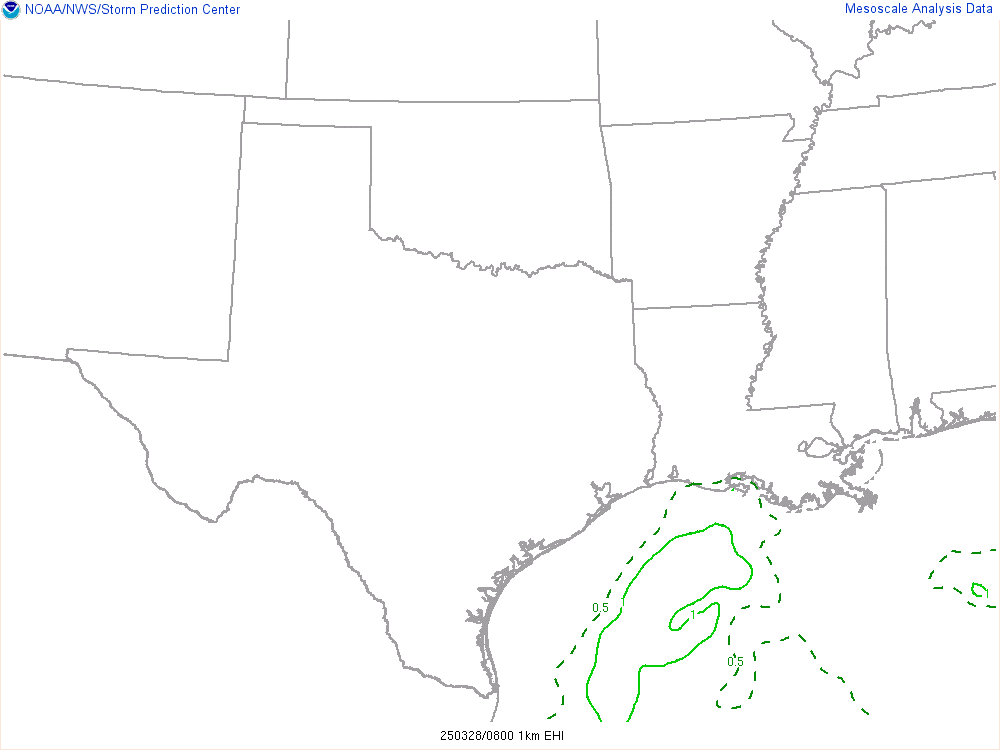
The Energy-Helicity Index (EHI) is a meteorological parameter that combines measures of both convective available potential energy (CAPE) and helicity. It is used to assess the potential for supercell thunderstorm development and tornado formation. The EHI provides valuable insights into the atmospheric conditions conducive to severe weather events. Here’s a list of number values associated with the Energy-Helicity Index and their interpretations:
- Low EHI (0-1):
- Suggests a minimal potential for supercell thunderstorms and tornadoes.
- Typically indicates less favorable conditions for severe weather.
- Moderate EHI (1-5):
- Signifies a moderate potential for supercell development and tornadoes.
- Suggests the possibility of severe weather events.
- High EHI (5-10):
- Indicates a significant potential for supercell thunderstorms and tornadoes.
- Suggests a heightened risk of severe weather, including the formation of strong tornadoes.
- Very High EHI (10 and above):
- Signifies an extremely favorable environment for supercell development and severe weather.
- Suggests a high risk of severe weather events, with the potential for violent, long-lived tornadoes.
Meteorologists use the Energy-Helicity Index to assess the combination of energy available for storm development (CAPE) and the rotation and vorticity in the atmosphere (helicity). A higher EHI value indicates a greater likelihood of severe weather, with the potential for supercells and tornadoes. This information is crucial for issuing timely warnings and advisories to protect communities from the destructive forces of severe weather. Understanding the EHI improves the accuracy of severe weather forecasting and helps reduce the impact of these events on society.
Showalter Index
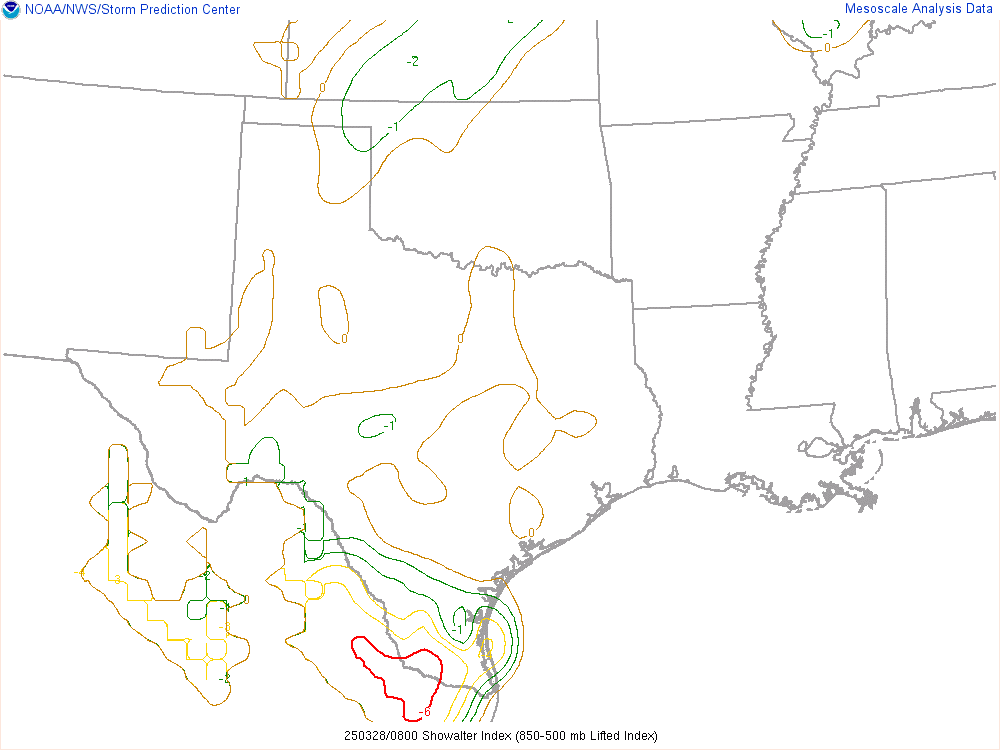
The Showalter Index is a parameter that measures the potential for atmospheric instability, specifically focusing on the presence of elevated convection within the atmosphere. It is often used to assess the likelihood of thunderstorm development and severe weather. The Showalter Index takes into account the temperature of a parcel of air lifted to a particular pressure level and compares it to the surrounding air’s temperature at that level. Here’s a list of number values associated with the Showalter Index and their implications:
- Positive Showalter Index (+1 to +3):
- Suggests a relatively stable atmosphere with limited potential for thunderstorm development.
- Typically indicative of favorable weather conditions.
- Near Zero Showalter Index (-1 to +1):
- Indicates a marginally unstable atmosphere with a low potential for thunderstorms.
- May lead to isolated or less severe convective activity.
- Negative Showalter Index (-1 to -3):
- Suggests an unstable atmosphere with a reasonable potential for thunderstorm development.
- May lead to more widespread and potentially severe thunderstorms.
- Strongly Negative Showalter Index (below -3):
- Signifies a highly unstable atmosphere with a significant potential for severe weather, including strong thunderstorms and severe hail.
Meteorologists use the Showalter Index to assess the degree of atmospheric instability and predict the likelihood of thunderstorms and severe weather. Lower Showalter Index values suggest a more favorable environment for convection and severe weather, while positive values indicate a more stable atmosphere. This index helps in issuing timely weather warnings and advisories, enhancing public safety and preparedness during severe weather events.
Significant Hail Chance
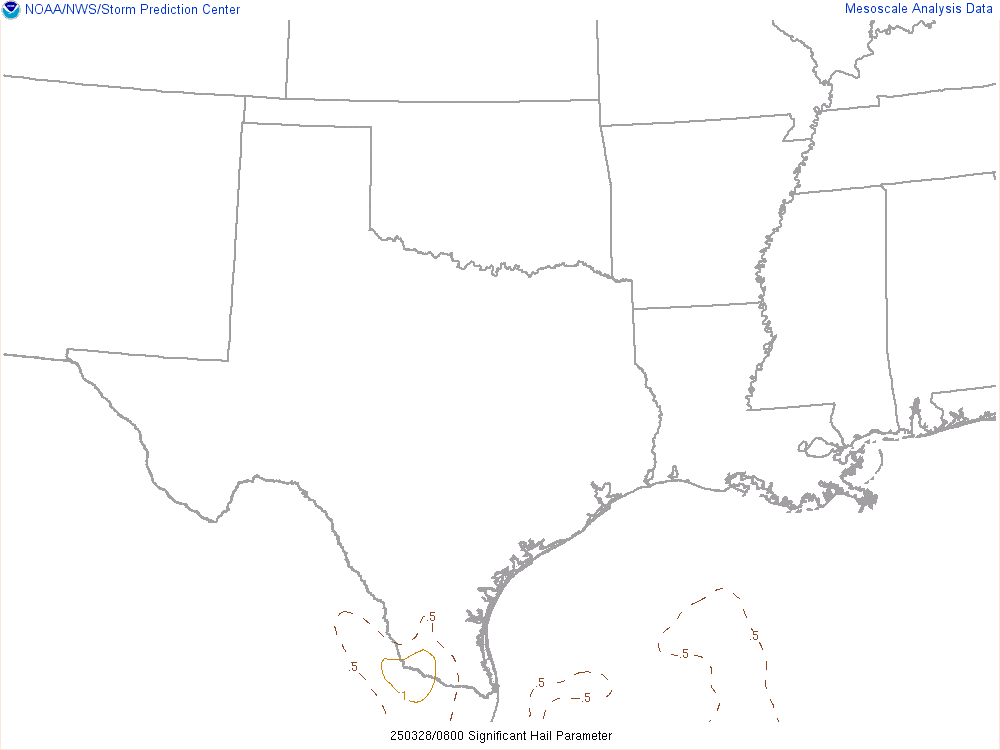
The Significant Hail Chance (SHC) is a parameter used to assess the likelihood of significant hail formation in a given area. Hail is a type of severe weather event that can cause substantial damage to crops, vehicles, buildings, and pose a threat to human safety. The SHC provides valuable information to meteorologists and the public to prepare for such events. Here’s a list of number values associated with the Significant Hail Chance and their implications:
- Low SHC (0-10%):
- Suggests a low likelihood of significant hail formation.
- Typically associated with benign or non-severe weather conditions.
- Moderate SHC (10-30%):
- Indicates a moderate potential for significant hail.
- May lead to sporadic hail events, but they are not expected to be widespread or severe.
- High SHC (30-50%):
- Signifies a substantial likelihood of significant hail.
- Implies a heightened risk of hailstorms, which can lead to local damage.
- Very High SHC (above 50%):
- Indicates an extremely favorable environment for significant hail.
- Suggests a high risk of severe hail events, with the potential for large hailstones that can cause extensive damage.
Meteorologists use the Significant Hail Chance to assess the potential for severe hail and issue timely warnings and advisories to protect property, agriculture, and public safety. Understanding this parameter helps in improving weather forecasts and preparedness for hail-related impacts.
SARS Hail Size
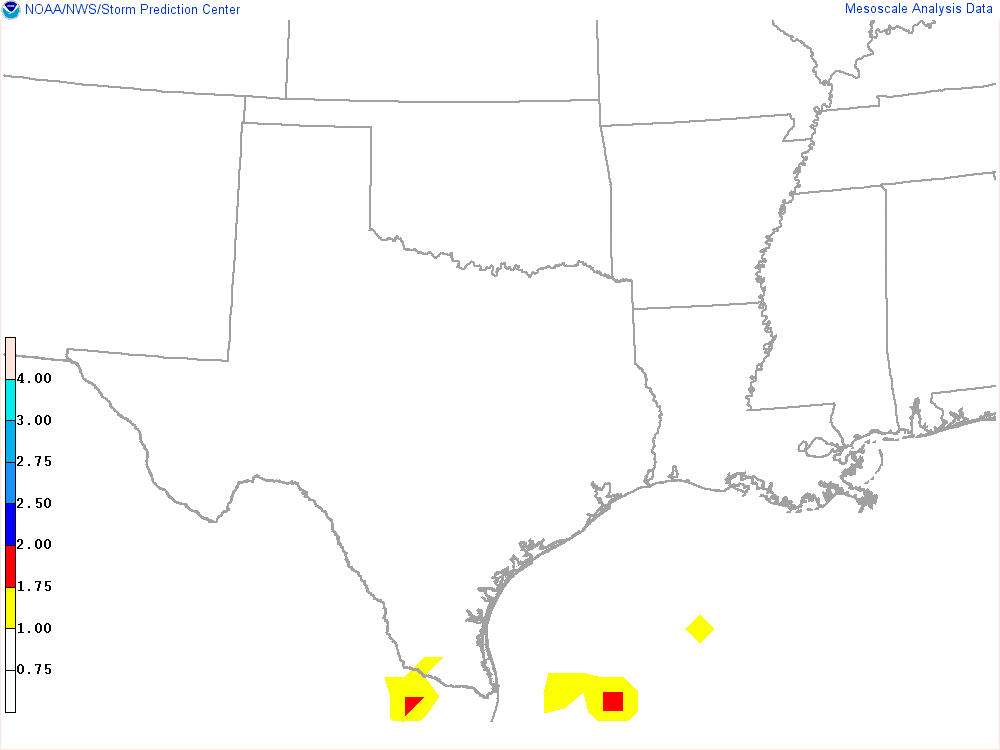
SARS Hail Size (Supercell Composite Reflectivity of the Maximum Expected Hail Size) is a parameter used to predict the size of hail that may occur within a severe thunderstorm. Hailstorms can be particularly destructive, causing damage to crops, vehicles, and structures. The SARS Hail Size parameter helps meteorologists and the public anticipate the potential impact of hail within a given storm. Here’s a list of number values associated with SARS Hail Size and their implications:
- Small Hail (less than 1 inch or 2.5 cm):
- SARS Hail Size values at the lower end suggest the likelihood of small hail.
- Typically results in minimal property damage and a low risk to public safety.
- Moderate Hail (1-1.5 inches or 2.5-3.8 cm):
- SARS Hail Size values in this range indicate the potential for moderate-sized hailstones.
- May cause some damage to vehicles and minor property damage.
- Large Hail (1.5-2 inches or 3.8-5 cm):
- Suggests the likelihood of large hail that can cause significant damage to vehicles and property.
- May pose a risk to public safety.
- Very Large Hail (2 inches or more or 5 cm and above):
- SARS Hail Size values at the upper end indicate the potential for very large hailstones.
- These hailstones can cause extensive damage, pose a severe risk to public safety, and result in significant financial losses.
Meteorologists use the SARS Hail Size parameter to assess the potential hail size in thunderstorms, which is essential for issuing accurate warnings and advisories, enabling people to take necessary precautions and mitigate hail-related risks. Understanding this parameter enhances public safety and property protection during severe weather events.
SARS Significant Hail %
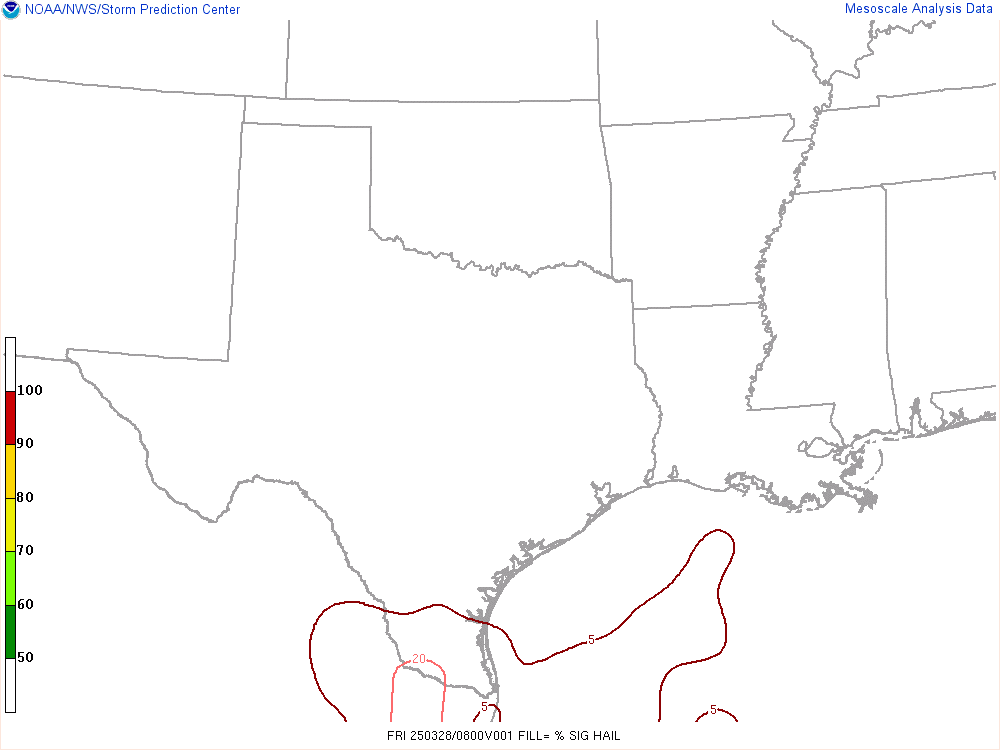
The SARS Significant Hail Chance (Supercell Composite Reflectivity Significant Hail Chance) is a parameter used to estimate the likelihood of significant hail occurring within a severe thunderstorm. Hail can cause extensive damage to property, crops, and pose risks to human safety. The SARS Significant Hail Chance parameter helps meteorologists and the public prepare for and respond to hailstorms. Here’s a list of number values associated with the SARS Significant Hail Chance and their interpretations:
- Low Significant Hail Chance (0-10%):
- Suggests a low probability of significant hail formation.
- Typically associated with benign or non-severe weather conditions.
- Moderate Significant Hail Chance (10-30%):
- Indicates a moderate potential for significant hail.
- May result in sporadic hail events but not expected to be widespread or particularly severe.
- High Significant Hail Chance (30-50%):
- Signifies a substantial likelihood of significant hail.
- Implies an increased risk of hailstorms, which can lead to local damage.
- Very High Significant Hail Chance (above 50%):
- Indicates an extremely favorable environment for significant hail.
- Suggests a high risk of severe hail events with the potential for large, damaging hailstones.
Meteorologists use the SARS Significant Hail Chance to assess the potential for severe hail and issue timely warnings and advisories to protect property, agriculture, and public safety. Understanding this parameter helps improve weather forecasts and preparedness for hail-related impacts, enhancing public safety and reducing the economic impact of hailstorms.
Significant Tornado
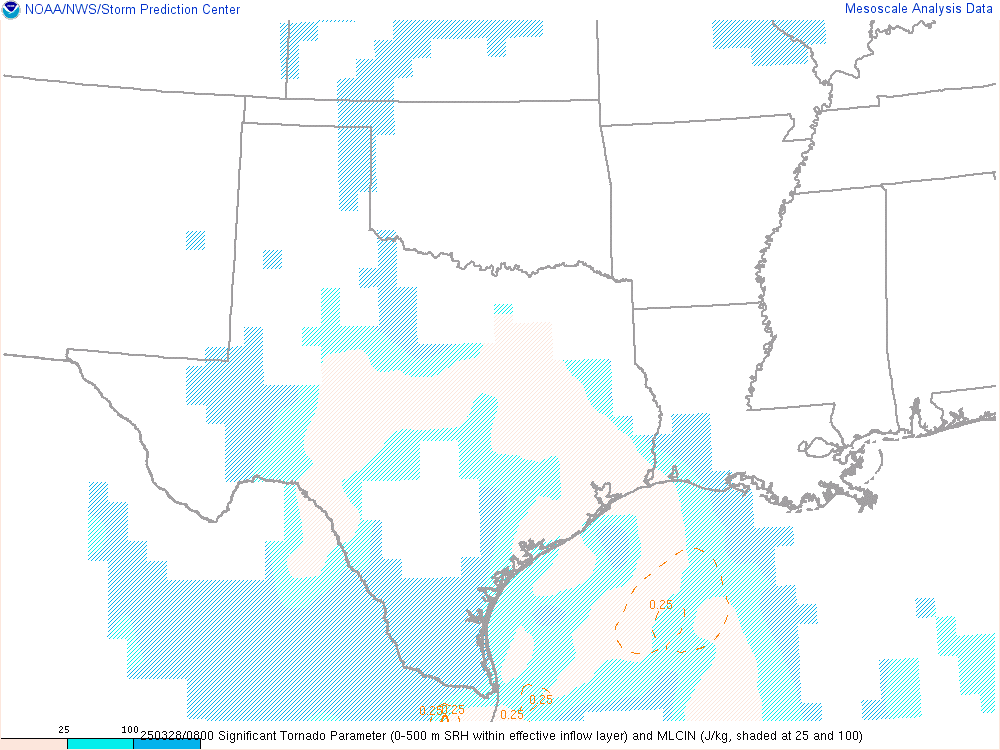
The Significant Tornado parameter, often referred to as SigTornado, is an index used to assess the potential for significant and violent tornadoes within a severe thunderstorm or supercell. Tornadoes are among the most destructive and life-threatening weather phenomena, and predicting their severity is crucial for public safety and preparedness. Here’s a list of number values associated with the Significant Tornado parameter and their interpretations:
- Low SigTornado (0-1):
- Suggests a low likelihood of significant tornado development.
- Typically indicative of benign or non-severe weather conditions.
- Moderate SigTornado (1-3):
- Indicates a moderate potential for significant tornadoes.
- Suggests a chance of isolated or non-severe tornado events.
- High SigTornado (3-6):
- Signifies a substantial likelihood of significant tornado development.
- Implies an increased risk of tornadoes, including potentially strong ones.
- Very High SigTornado (above 6):
- Indicates an extremely favorable environment for significant and violent tornadoes.
- Suggests a high risk of severe tornado events, including long-lived and violent ones.
Meteorologists use the Significant Tornado parameter to assess the potential for tornadoes and their severity. Higher SigTornado values suggest a more favorable environment for the development of significant tornadoes. Understanding this parameter is critical for issuing accurate tornado warnings and advisories, enhancing public safety, and minimizing the impact of these destructive events.
Probability of EF0+
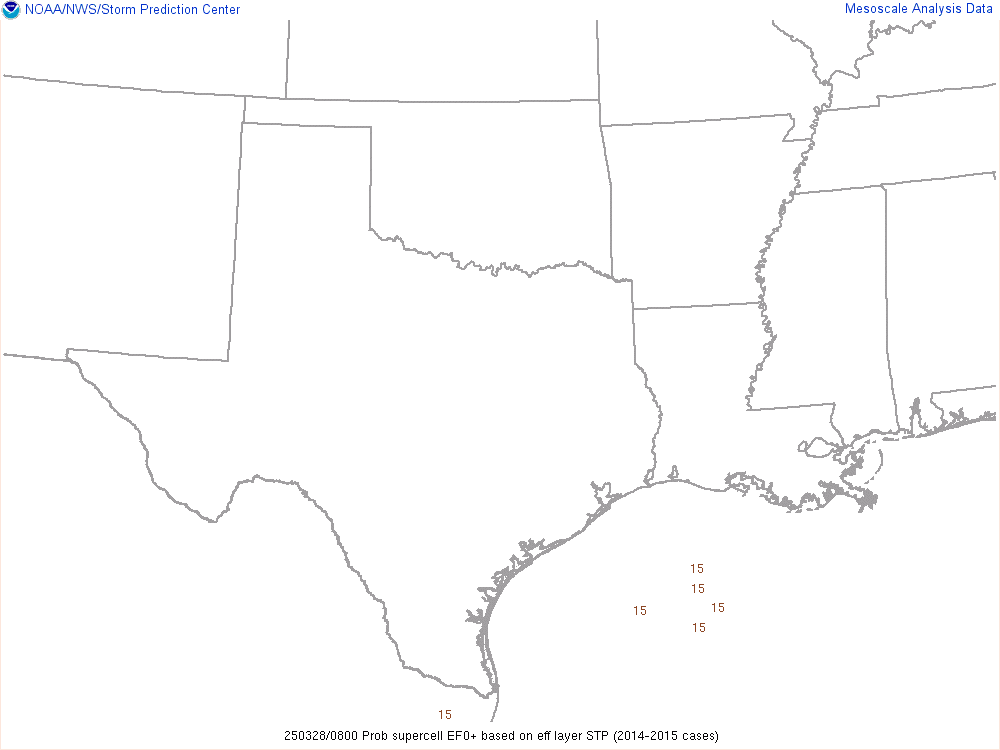
The Probability of EF-0 Tornado is a meteorological parameter used to estimate the likelihood of a tornado occurring at the EF-0 intensity level on the Enhanced Fujita (EF) scale. EF-0 tornadoes are the weakest on the scale, with wind speeds between 65 and 85 miles per hour (105-137 km/h). While they are less destructive than stronger tornadoes, EF-0 tornadoes can still cause damage to buildings and vegetation. Here’s a list of number values associated with the Probability of EF-0 Tornado and their implications:
- Low Probability (0-10%):
- Suggests a low chance of an EF-0 tornado occurring.
- Typically indicative of non-severe or benign weather conditions.
- Moderate Probability (10-30%):
- Indicates a moderate chance of an EF-0 tornado.
- Suggests the potential for isolated EF-0 tornadoes within a given area.
- High Probability (30-50%):
- Signifies a substantial likelihood of EF-0 tornado development.
- Implies an increased risk of EF-0 tornadoes, often associated with severe weather events.
- Very High Probability (above 50%):
- Indicates an extremely favorable environment for EF-0 tornadoes.
- Suggests a high risk of EF-0 tornadoes, often associated with more significant severe weather outbreaks.
Meteorologists use the Probability of EF-0 Tornado to assess the potential for tornadoes at this lower intensity level. Higher values suggest a greater likelihood of EF-0 tornadoes, often linked to convective storm systems. Understanding this parameter helps in issuing accurate tornado warnings and advisories, enhancing public safety, and minimizing property and crop damage.
Probability of EF2+
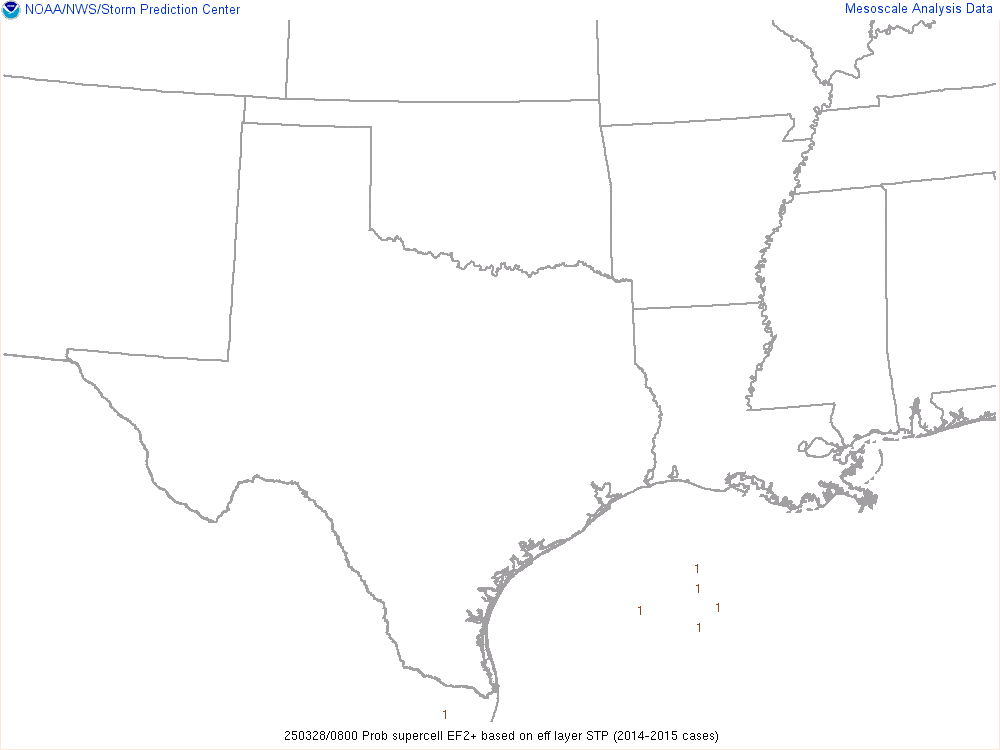
The Probability of EF-2 Tornado is a meteorological parameter used to estimate the likelihood of a tornado occurring at the EF-2 intensity level on the Enhanced Fujita (EF) scale. EF-2 tornadoes are characterized by wind speeds between 111 and 135 miles per hour (179-217 km/h) and can cause significant damage to buildings and vegetation. Here’s a list of number values associated with the Probability of EF-2 Tornado and their implications:
- Low Probability (0-10%):
- Suggests a low chance of an EF-2 tornado occurring.
- Typically indicative of non-severe or benign weather conditions.
- Moderate Probability (10-30%):
- Indicates a moderate chance of an EF-2 tornado.
- Suggests the potential for isolated EF-2 tornadoes within a given area.
- High Probability (30-50%):
- Signifies a substantial likelihood of EF-2 tornado development.
- Implies an increased risk of EF-2 tornadoes, often associated with severe weather events.
- Very High Probability (above 50%):
- Indicates an extremely favorable environment for EF-2 tornadoes.
- Suggests a high risk of EF-2 tornadoes, often associated with more significant severe weather outbreaks.
Meteorologists use the Probability of EF-2 Tornado to assess the potential for tornadoes at this intensity level, which can lead to notable property damage. Higher values suggest a greater likelihood of EF-2 tornadoes, often linked to convective storm systems. Understanding this parameter helps in issuing accurate tornado warnings and advisories, enhancing public safety, and minimizing property and crop damage.
Probability of EF4+
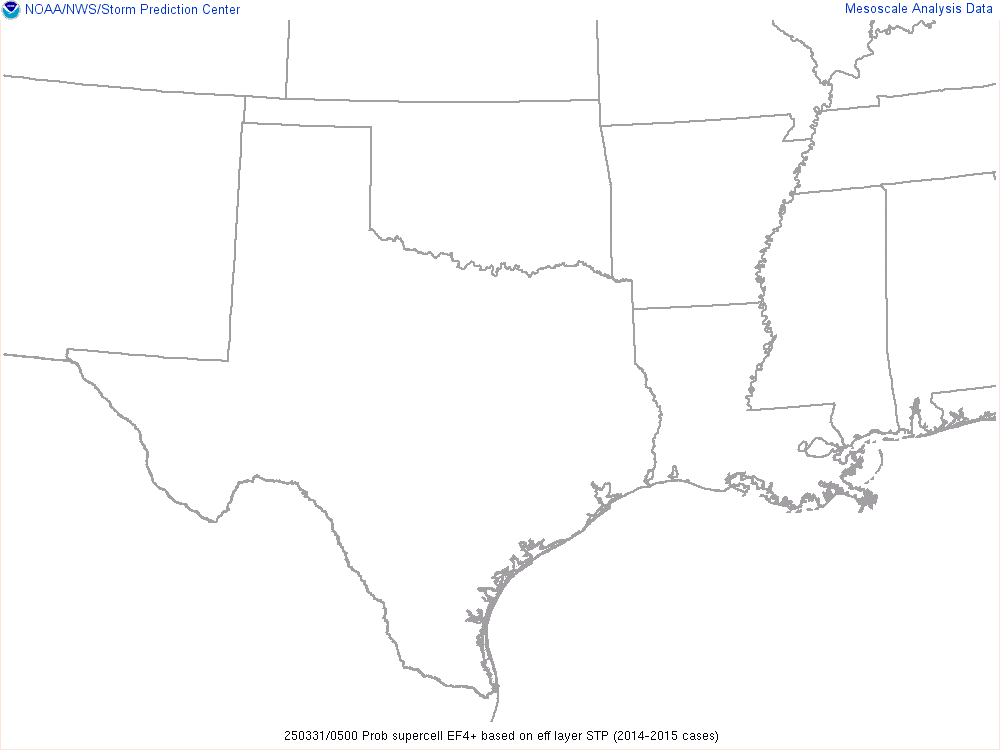
The Probability of EF-4 Tornado is a meteorological parameter used to assess the likelihood of a tornado occurring at the EF-4 intensity level on the Enhanced Fujita (EF) scale. EF-4 tornadoes are characterized by violent wind speeds ranging from 166 to 200 miles per hour (267-322 km/h). These tornadoes can cause extensive damage to buildings and landscapes and pose a significant threat to life and safety. Here’s a list of number values associated with the Probability of EF-4 Tornado and their implications:
- Low Probability (0-10%):
- Suggests a low chance of an EF-4 tornado occurring.
- Typically indicative of non-severe or benign weather conditions.
- Moderate Probability (10-30%):
- Indicates a moderate chance of an EF-4 tornado.
- Suggests the potential for isolated EF-4 tornadoes within a given area.
- High Probability (30-50%):
- Signifies a substantial likelihood of EF-4 tornado development.
- Implies an increased risk of EF-4 tornadoes, often associated with severe weather events.
- Very High Probability (above 50%):
- Indicates an extremely favorable environment for EF-4 tornadoes.
- Suggests a high risk of EF-4 tornadoes, often linked to significant and severe weather outbreaks.
Meteorologists use the Probability of EF-4 Tornado to assess the potential for these violent tornadoes, which can result in catastrophic damage. Higher values indicate a greater likelihood of EF-4 tornadoes, often associated with intense and destructive supercell thunderstorms. Understanding this parameter is crucial for issuing accurate tornado warnings and advisories, enhancing public safety, and minimizing the impact of these severe events.





